Curated by The Modern Language Experiment
Cathy Lomax | Colin Perry | Jon Cairns
8th December - Cathy Lomax 3 - 4.30pm
9th December - Colin Perry 1 - 2.30pm
9th December - Jon Cairns 3 - 4.30pm
The Modern Language Experiment will hold the second part of their lecture programme 'sudo document' at Angus-Hughes Gallery. Cathy Lomax, Colin Perry & Jon Cairns will each give a lecture about their current research.
SATURDAY 8TH DECEMBER 2012, 3 - 4.30pm
CATHY LOMAX
Is an artist and Director of Transition Gallery based in east London. Transition is an independent and innovative gallery/publisher founded in October 2002. The gallery shows work by both emerging and established contemporary artists as well as producing publications and periodicals. Cathy's lecture will be about:
The traditional gallery system is distasteful – gentleman gallerists carousing with oligarchs to flog overpriced artworks by artists who often profess to have a social conscience. The alternative is working within the subsidised arts where securing funding is a prize only awarded to those who know how to play the game.
The whole system is full of contradictions and being an artist is as hard as it always has been. Artists need to take control and devise new models – stop the researching and the empty words and start doing. The way forward is not to compartmentalise but to integrate the making, showing, working and watching.
SUNDAY 9TH DECEMBER 1 - 2.30PM
COLIN PERRY
Is a freelance art writer based in London, UK. Colin writes reviews and profiles for Art Monthly, Frieze, ArtReview, Art in America, Modern Painters, Catalogue magazine, MAP, and catalogue texts. Currently he is working part-time as an editor at Phaidon and has presented talks with artists and academics, organised film screenings, and collaborated with artists on texts and performances. For his lecture Colin will be discussing:
Into the mainstream: Experimental film and video on TV
In recent years, there has been a growing interest in artistic strategies for intervening in broadcast television. At the same time, there has also been a expanding fascination with typologies of documentary film and video, with essay-film formats appearing in galleries across the global art network. These forms have an entwined history that is rarely discussed; their existence has important implications for how we produce and consume artistic forms and for how artistic production is funded.
There is a long history of experimental documentary in Britain, from the GPO to Channel Four’s investment in experimental film and video. But these changes have not taken place ‘top-down’. Rather, artists to have been able to win funding by forming pressure groups and collectives and combining across sectarian divides. This history shows that – even in a recession – the power of combination and collectivity can create opportunities for art beyond the commercial sphere. The talk will explore these concerns, using the works of Stuart Marshall and Marc Karlin as an example.
SUNDAY 9TH DECEMBER 3 - 4.30PM
JON CAIRNS
Is Co-ordinator of Critical Studies for BA Fine Art at Central St. Martins. Jon's work in the last few years has engaged with queer historiography and the ambivalence of interpretation, hinging on the mobile relationships between photography and performance, and between ‘fact’ and ‘fiction’. For his lecture Jon will be discussing:
Feeling Your Way: art, affect and value in times of recession
There has been a renewed urgency to questions of value in the context of cultural retrenchment (brought on by cuts to arts funding, education spending etc) and the consequent threat of a return to old hierarchies of class and access when it comes to the production of fine art. In the course of my research for a special issue of Visual Culture in Britain, I have come into contact with numerous small and independent artist-run initiatives, who have repeatedly stressed the value and importance of collaboration, informality and surprise. I note a frequent prioritisation of ‘content’ and the critical encounter with art over the usual exigencies of commerce and funding.
The significance of the intuitive, the experiential, the quality and range of audience response may be perennial concerns, but I wonder whether this emphasis on the ‘affective’ structures of art – its display, how we interact with it and come to understand it – has a particular resonance right now. What kind of affective communities does art solicit and construct today? What might affect’s political value be in a moment of cultural crisis?
This weekend will be the final series in the programme and we would like to thank all the contributers in giving over their time to the project and allowing us an insight into their important research. We would also like to warmly thank Goldsmiths, Univeristy of London's Annual Fund for their kind support for 'sudo document'.
For more information contact@modernlanguageexperiment.org
www.modernlanguageexperiment.org
Sudo document
Sudo, in its purest form, evokes ownership ‘su’ and action ‘do’.
As the education sector in the UK moves into a new unprecedented period of change we feel that it is important to take ownership of our own educational paths and evoke action.
We are pleased to present “sudo document”, an educational programme consisting of a series of lectures and talks that will allow accessibility to the thoughts, ideologies and pedagogical studies of important Curators, Artists and Gallerists throughout the UK working both independently or through institutions.
These lectures, once presented, will be edited and broadcast immediately online serving as both a ‘sudo document’ and a reference video to be viewed at all times.
These lectures and talks will then form a publication that will be launched after the educational programme is completed; this will feature an over view of the programme as well as artworks and writings from all the contributors. This will be made available for reference at insitutional libraries (Goldsmiths College, Central St.Martins) and also for sale in bookshops.
Lecture programme for December 2012 at
Angus-Hughes Gallery
8th December - Cathy Lomax 3 - 4.30pm
9th December - Colin Perry 1 - 2.30 pm
9th December - Jon Cairns 3 - 4.30pm
Past lecture programme for August - September 2012 at
Lubomirov-Easton
31st August - Mark Jackson 6.30 – 8pm
8th September – Cedar Lewisohn 3 – 4pm
15th September – Carlos Noronha Feio 3 – 4.30pm
Carlos Noronha Feio - Has a diverse practice that includes actions, performance, video, drawing, painting, photography and installation as research into cultural, local and global identity. He frequently adopts culturally significant images, locations and symbols as a form of creative interference with meaning, and demonstrates the almost arbitrary nature in which cultural significance is adopted or interpreted. Noronha Feio runs The Mews Project Space, an artist run project in an out building located in an alley at the back of the newly refurbished Whitechapel Art Gallery.
He is currently doing a PhD at the Royal College of Art where he is researching dispositifs that artists and non artists alike can assimilate and disseminate. Enabling them to employ in a non abstract manner, strategies that empower the individual in relation to the modern state, to the Sovereign.
For this talk, Noronha Feio will be speaking about his Art4Debt project, and the way that utilising the language of finance a sense of true Global citizenry, of borderlesness and real accountability can be reached.
Cathy Lomax - Is an artist and Director of Transition Gallery. Transition is an independent and innovative gallery and publisher founded in October 2002. The gallery shows work by both emerging and established contemporary artists as well as producing publications and periodicals. Cathy's lecture will be about:
The traditional gallery system is distasteful – gentleman gallerists carousing with oligarchs to flog overpriced artworks by artists who often profess to have a social conscience. The alternative is working within the subsidised arts where securing funding is a prize only awarded to those who know how to play the game.
The whole system is full of contradictions and being an artist is as hard as it always has been. Artists need to take control and devise new models – stop the researching and the empty words and start doing. The way forward is not to compartmentalise but to integrate the making, showing, working and watching.
Cedar Lewisohn – Is an artist and curator based in London. He curated the exhibition Street Art at Tate Modern in 2008 and co-curated the exhibition Rude Britannia at Tate Britain in 2010. In 2010 he co-curated the UK touring exhibition Orbitecture and in 2012 he curated the exhibition Les Flaur de Mal at the BWA Gallery, Wrocław , Poland. In 2008 he wrote the book, Street Art: The Graffiti Revolution (Tate), and in 2011 his book Abstract Graffiti was published by Merell.
Cedar will be speaking about his art practice and how this informs his curatorial practice.
Colin Perry - Is a freelance art writer based in London, UK. Colin writes reviews and profiles for Art Monthly, Frieze, ArtReview, Art in America, Modern Painters, Catalogue magazine, MAP, and catalogue texts. Currently he is working part-time as an editor at Phaidon and has presented talks with artists and academics, organised film screenings, and collaborated with artists on texts and performances. For his lecture Colin will be discussing:
Into the mainstream: Experimental film and video on TV
In recent years, there has been a growing interest in artistic strategies for intervening in broadcast television. At the same time, there has also been a expanding fascination with typologies of documentary film and video, with essay-film formats appearing in galleries across the global art network. These forms have an entwined history that is rarely discussed; their existence has important implications for how we produce and consume artistic forms and for how artistic production is funded.
There is a long history of experimental documentary in Britain, from the GPO to Channel Four’s investment in experimental film and video. But these changes have not taken place ‘top-down’. Rather, artists to have been able to win funding by forming pressure groups and collectives and combining across sectarian divides. This history shows that – even in a recession – the power of combination and collectivity can create opportunities for art beyond the commercial sphere. The talk will explore these concerns, using the works of Stuart Marshall and Marc Karlin as an example.
Jon Cairns - Is Co-ordinator of Critical Studies for BA Fine Art at Central St. Martins. Jon's work in the last few years has engaged with queer historiography and the ambivalence of interpretation, hinging on the mobile relationships between photography and performance, and between ‘fact’ and ‘fiction’. For his lecture Jon will be disscussing:
Feeling Your Way: art, affect and value in times of recession
There has been a renewed urgency to questions of value in the context of cultural retrenchment (brought on by cuts to arts funding, education spending etc) and the consequent threat of a return to old hierarchies of class and access when it comes to the production of fine art. In the course of my research for a special issue of Visual Culture in Britain, I have come into contact with numerous small and independent artist-run initiatives, who have repeatedly stressed the value and importance of collaboration, informality and surprise. I note a frequent prioritisation of ‘content’ and the critical encounter with art over the usual exigencies of commerce and funding.
The significance of the intuitive, the experiential, the quality and range of audience response may be perennial concerns, but I wonder whether this emphasis on the ‘affective’ structures of art – its display, how we interact with it and come to understand it – has a particular resonance right now. What kind of affective communities does art solicit and construct today? What might affect’s political value be in a moment of cultural crisis?
Mark Jackson – Is a curator both at IMT Gallery, which he co-founded in 2005, and independently. After receiving a First in Fine Art Painting at the University of East London he studied an MA in Fine Art Media at the Slade School of Fine Art, specialising in sound and audiovisual practice. He has a particular interest in inter-disciplinary practice and is also an associate lecturer at London College of Communication where he is currently writing up his PhD.
His research considers the experiments with sound and concepts of space of William S. Burroughs in the '60s and '70s as the basis for a curatorial strategy for sound art. His research has led to him curating exhibitions around previously unexhibited work by William Burroughs: Dead Fingers Talk at IMT Gallery in 2010, which toured to Galleri Box, Gothenburg, in 2012, Silencer at Payne Shurvell, London, in 2010 and the recent Swarms of Black Flies Make the Roses Purple at IMT Gallery in 2012.
Mark is a frequent guest speaker and lecturer in a broad range of fields including fine art, arts funding, music and curating, and was visiting professor at Trinity College of Music in 2004. He is currently working on the forthcoming programme of exhibitions at IMT Gallery alongside projects at Angus-Hughes Gallery and the London College of Communication. For his lecture he will be discussing the relationship between his role as curator at IMT Gallery and his PhD research.
We would like to thank Goldsmiths, University of London's annual fund for their kind support.
![]() “The contemporary art space is a space in which multitudes can view themselves and celebrate themselves… in a way that assists them in reflecting upon their own condition, offering them an opportunity to exhibit themselves to themselves.” Groys, B, Going Public 2010 p.63
Are we as readers and visitors to arts contemporary spaces aware of ourselves?
The spectator’s experience of a work of art is, in the most part, dependent on what they bring with them and what they understand about the work but the spectator is much more then a member of a momentary group that go to see this thing, then move over there and observe that thing; they are a community. The position and power of the spectator as implied by the work of art has been a central question from the time of Denis Diderot, and has been regularly contested from Roland Barthes essay The Death of the Author to Michael Fried’s call for the passivity of the audience.
As the art world moves in to a new stage of social and political change this exhibition will once again pull focus on the spectator that Boris Groys describes as a self-aware community that has already been conditioned by the art world’s numerous emancipatory and participatory projects. This community has already accepted its participatory role, actively welcomed its new authorities, and is ready to reject or accept any denigration offered. This exhibition then will re-examine the position and power of the spectator by looking at what has caused this preoccupation with the spectator, the work of art and the artist; and ask whether these new forms of encounter empower or denigrates the audience.
The artists selected for this exhibition create artworks, interventions and projects that use, as a fundamental part, the spectator in three distinct categories, the spectator as a participant, the spectator as a community, and the spectator as subject matter. These will serve as active interlocutors to continue this discussion through the duration of the exhibition.
contact@modernlanguageexperiment.org
www.modernlanguageexperiment.org
Talk: Monday 18 June, from 7pm
Accompanying Publication
Video Works
Patrick Coyle - illusion of the spectator, Friday 8th June 2012
Beth Fox - 'A marvellous negative capability', 2012
Exhibition photographs by Matthew Stock
Beth Fox - 'A marvellous negative capability', 2012
“The contemporary art space is a space in which multitudes can view themselves and celebrate themselves… in a way that assists them in reflecting upon their own condition, offering them an opportunity to exhibit themselves to themselves.” Groys, B, Going Public 2010 p.63
Are we as readers and visitors to arts contemporary spaces aware of ourselves?
The spectator’s experience of a work of art is, in the most part, dependent on what they bring with them and what they understand about the work but the spectator is much more then a member of a momentary group that go to see this thing, then move over there and observe that thing; they are a community. The position and power of the spectator as implied by the work of art has been a central question from the time of Denis Diderot, and has been regularly contested from Roland Barthes essay The Death of the Author to Michael Fried’s call for the passivity of the audience.
As the art world moves in to a new stage of social and political change this exhibition will once again pull focus on the spectator that Boris Groys describes as a self-aware community that has already been conditioned by the art world’s numerous emancipatory and participatory projects. This community has already accepted its participatory role, actively welcomed its new authorities, and is ready to reject or accept any denigration offered. This exhibition then will re-examine the position and power of the spectator by looking at what has caused this preoccupation with the spectator, the work of art and the artist; and ask whether these new forms of encounter empower or denigrates the audience.
The artists selected for this exhibition create artworks, interventions and projects that use, as a fundamental part, the spectator in three distinct categories, the spectator as a participant, the spectator as a community, and the spectator as subject matter. These will serve as active interlocutors to continue this discussion through the duration of the exhibition.
contact@modernlanguageexperiment.org
www.modernlanguageexperiment.org
Talk: Monday 18 June, from 7pm
Accompanying Publication
Video Works
Patrick Coyle - illusion of the spectator, Friday 8th June 2012
Beth Fox - 'A marvellous negative capability', 2012
Exhibition photographs by Matthew Stock
Beth Fox - 'A marvellous negative capability', 2012
![]()
![]()
![]() Craig Cooper - 'Spatial Territory', 2012
Craig Cooper - 'Spatial Territory', 2012
![]()
![]()
![]()
![]()
![]()
![]()
![]() Charlotte Norwood - 'But that's just the point, someone might object (Balls and Strkes of ‘96)', 2012
Charlotte Norwood - 'But that's just the point, someone might object (Balls and Strkes of ‘96)', 2012
![]()
![]()
![]() Kate Janes - 'yellow hats and hammers', 2012
Kate Janes - 'yellow hats and hammers', 2012
![]()
![]() Maite Zabala - 'Gemini', 2011
Maite Zabala - 'Gemini', 2011
![]()
![]() Matthew Stock - 'Perplications', 2012
Matthew Stock - 'Perplications', 2012
![]()
![]() Patrick Coyle - ' 'Illusion of the spectator Friday 8th June 2012' '
Patrick Coyle - ' 'Illusion of the spectator Friday 8th June 2012' '
![]()
![]()
![]()
![]()
![]()
![]() Installation Views
Installation Views
![]()
![]()
 “The contemporary art space is a space in which multitudes can view themselves and celebrate themselves… in a way that assists them in reflecting upon their own condition, offering them an opportunity to exhibit themselves to themselves.” Groys, B, Going Public 2010 p.63
Are we as readers and visitors to arts contemporary spaces aware of ourselves?
The spectator’s experience of a work of art is, in the most part, dependent on what they bring with them and what they understand about the work but the spectator is much more then a member of a momentary group that go to see this thing, then move over there and observe that thing; they are a community. The position and power of the spectator as implied by the work of art has been a central question from the time of Denis Diderot, and has been regularly contested from Roland Barthes essay The Death of the Author to Michael Fried’s call for the passivity of the audience.
As the art world moves in to a new stage of social and political change this exhibition will once again pull focus on the spectator that Boris Groys describes as a self-aware community that has already been conditioned by the art world’s numerous emancipatory and participatory projects. This community has already accepted its participatory role, actively welcomed its new authorities, and is ready to reject or accept any denigration offered. This exhibition then will re-examine the position and power of the spectator by looking at what has caused this preoccupation with the spectator, the work of art and the artist; and ask whether these new forms of encounter empower or denigrates the audience.
The artists selected for this exhibition create artworks, interventions and projects that use, as a fundamental part, the spectator in three distinct categories, the spectator as a participant, the spectator as a community, and the spectator as subject matter. These will serve as active interlocutors to continue this discussion through the duration of the exhibition.
contact@modernlanguageexperiment.org
www.modernlanguageexperiment.org
Talk: Monday 18 June, from 7pm
Accompanying Publication
Video Works
Patrick Coyle - illusion of the spectator, Friday 8th June 2012
Beth Fox - 'A marvellous negative capability', 2012
Exhibition photographs by Matthew Stock
Beth Fox - 'A marvellous negative capability', 2012
“The contemporary art space is a space in which multitudes can view themselves and celebrate themselves… in a way that assists them in reflecting upon their own condition, offering them an opportunity to exhibit themselves to themselves.” Groys, B, Going Public 2010 p.63
Are we as readers and visitors to arts contemporary spaces aware of ourselves?
The spectator’s experience of a work of art is, in the most part, dependent on what they bring with them and what they understand about the work but the spectator is much more then a member of a momentary group that go to see this thing, then move over there and observe that thing; they are a community. The position and power of the spectator as implied by the work of art has been a central question from the time of Denis Diderot, and has been regularly contested from Roland Barthes essay The Death of the Author to Michael Fried’s call for the passivity of the audience.
As the art world moves in to a new stage of social and political change this exhibition will once again pull focus on the spectator that Boris Groys describes as a self-aware community that has already been conditioned by the art world’s numerous emancipatory and participatory projects. This community has already accepted its participatory role, actively welcomed its new authorities, and is ready to reject or accept any denigration offered. This exhibition then will re-examine the position and power of the spectator by looking at what has caused this preoccupation with the spectator, the work of art and the artist; and ask whether these new forms of encounter empower or denigrates the audience.
The artists selected for this exhibition create artworks, interventions and projects that use, as a fundamental part, the spectator in three distinct categories, the spectator as a participant, the spectator as a community, and the spectator as subject matter. These will serve as active interlocutors to continue this discussion through the duration of the exhibition.
contact@modernlanguageexperiment.org
www.modernlanguageexperiment.org
Talk: Monday 18 June, from 7pm
Accompanying Publication
Video Works
Patrick Coyle - illusion of the spectator, Friday 8th June 2012
Beth Fox - 'A marvellous negative capability', 2012
Exhibition photographs by Matthew Stock
Beth Fox - 'A marvellous negative capability', 2012


 Craig Cooper - 'Spatial Territory', 2012
Craig Cooper - 'Spatial Territory', 2012






 Charlotte Norwood - 'But that's just the point, someone might object (Balls and Strkes of ‘96)', 2012
Charlotte Norwood - 'But that's just the point, someone might object (Balls and Strkes of ‘96)', 2012


 Kate Janes - 'yellow hats and hammers', 2012
Kate Janes - 'yellow hats and hammers', 2012

 Maite Zabala - 'Gemini', 2011
Maite Zabala - 'Gemini', 2011

 Matthew Stock - 'Perplications', 2012
Matthew Stock - 'Perplications', 2012

 Patrick Coyle - ' 'Illusion of the spectator Friday 8th June 2012' '
Patrick Coyle - ' 'Illusion of the spectator Friday 8th June 2012' '





 Installation Views
Installation Views


 “The artists’ job is to be witness to his time in history” Robert Rauschenberg
Loser Art. Counter Culture. Subculture. Arte Povera. Street Art. DIY Art. Youth Art. Crap Art. Graffiti? Subversion... Interruption... Disruption.... The Bastard Children of Pop. Illegitimate. Below the radar. A bad taste in the mouth. The cracked mirror image of Pop, Neo Pop. All that is shiny and bright. And hollow. The witnesses.
As Neo Pop emerged as the direct descendent of Pop Art, the proliferation of larger than life celebrity bling, wanton consumerism and hollow gesture filled galleries, magazines and festivals around the world. Golden statues of Michael Jackson and Bubbles, Tiger sharks frozen in formaldehyde or life size manga cartoon statues with lasso like semen reflected the decade of excess that was being referenced and reflected upon. Popular culture had never seemed more perverse. Money was no object in the creation of these idols.
But there was an alternative faction forming within the Pop family. Subcultures had begun to emerge almost as soon as the term 'popular culture' had been termed. A desire to act in a contrary fashion to popular culture fuelled a growing group of artists who acted outside of and apparently against Pop. The slickness of Neo Pop was indeed a sickening sight to these artists and they began to use the leftovers and the discarded materials of their wealthier relatives. Where Neo Pop Artists revere Marvel comics, the Bastard children might reference internet pornography. Where Neo Pop artists might use diamonds, the Bastard Children used bathroom tiles.
In our Age of Austerity, it seems apt to begin to collect some of the artists who are representative of this movement. And it is a large movement even if they have yet to recognise it themselves. This show is a dispirate, desperate collection of detritus that demands to be acknowledged as a record of our times.
contact@modernlanguageexperiment.org
www.modernlanguageexperiment.org
Accompanying publication
Photographs of the exhibition by Keh Ng
Installation View
“The artists’ job is to be witness to his time in history” Robert Rauschenberg
Loser Art. Counter Culture. Subculture. Arte Povera. Street Art. DIY Art. Youth Art. Crap Art. Graffiti? Subversion... Interruption... Disruption.... The Bastard Children of Pop. Illegitimate. Below the radar. A bad taste in the mouth. The cracked mirror image of Pop, Neo Pop. All that is shiny and bright. And hollow. The witnesses.
As Neo Pop emerged as the direct descendent of Pop Art, the proliferation of larger than life celebrity bling, wanton consumerism and hollow gesture filled galleries, magazines and festivals around the world. Golden statues of Michael Jackson and Bubbles, Tiger sharks frozen in formaldehyde or life size manga cartoon statues with lasso like semen reflected the decade of excess that was being referenced and reflected upon. Popular culture had never seemed more perverse. Money was no object in the creation of these idols.
But there was an alternative faction forming within the Pop family. Subcultures had begun to emerge almost as soon as the term 'popular culture' had been termed. A desire to act in a contrary fashion to popular culture fuelled a growing group of artists who acted outside of and apparently against Pop. The slickness of Neo Pop was indeed a sickening sight to these artists and they began to use the leftovers and the discarded materials of their wealthier relatives. Where Neo Pop Artists revere Marvel comics, the Bastard children might reference internet pornography. Where Neo Pop artists might use diamonds, the Bastard Children used bathroom tiles.
In our Age of Austerity, it seems apt to begin to collect some of the artists who are representative of this movement. And it is a large movement even if they have yet to recognise it themselves. This show is a dispirate, desperate collection of detritus that demands to be acknowledged as a record of our times.
contact@modernlanguageexperiment.org
www.modernlanguageexperiment.org
Accompanying publication
Photographs of the exhibition by Keh Ng
Installation View
 Doug Fishbone
Doug Fishbone
 Ed Templeton
Ed Templeton
 Horn Head
Horn Head
 Jesse Darling
Jesse Darling
 Keh Ng
Keh Ng
 Pure Evil
Pure Evil
 Warren Garland
Warren Garland

 “There Will Be Others” is one of three shows that the Modern Language Experiment will be hosting at Angus Hughes Gallery. The show will be on from the 20th to 30th July 2012. The private view is on the 20th from 6pm to 9pm. The below is part of a conversation that Matt and Keh had when discussing the concept of the show.
M In considering the title for this show “There Will Be Others” I am conscious not to take the angle of there will be others to mean there will be other artists in the show, but rather there will always be photography and that photography will always want to replicate it self or be taken to be a medium that refuses to go away; I don’t think photography suffers in the same way as say painting; it has different conversations as regards to its position but not whether its valid or not.
K What’s different about photography and painting is that painting is always seen as an original. With regards to the title there will be others and what you said before about repetition holds true to photography rather then any other medium. I think photography and painting both suffer from an idea of deadness especially today, if they are not dead in some peoples eyes they are definitely half dead. Because they both come from a time of pre-modernity, pre-conceptual thinking in art so there is always skill level and aesthetic questions that deaden the work.
M In the way that you don’t get that with new technologies or even sculpture
K No because these operate in a post-modernity era.
M That isn’t to say that photography is not capable of operating like that I think photography can relinquish its history easier then painting.
K I think in terms of the title there will be others, its not necessarily about having other artists but other positions. What is interesting for me is how the concept for this was initially born from the discussion we had with Jeremy, Paul and Tina at Lo and Behold Gallery; it brought into focus not only important differing positions for the photographic image but also entry points for Magda, Karl and Thorsten to now contribute to this conversation.
M But what does it (the title) conjure up I felt that it is quite open ended, and yet its suggestive and I like that and it does not necessarily pin itself down to photography.
K So what we can say is that the way we process imagery today has changed. The frequency of image making (through the digital darkroom) has allowed for a vast freedom with printing, multiples. montage and retouching; the possibilities are now much freer.
M But then you have the problem of quality; there are a lot of bad images out there. There is greater access to bad images (internet, iPhone). Photography is very happy to sit anywhere, its a bit of a whore really, its happy to sit with art and also happy to sit with bad documentation photography
K but then in another context that same image could be a wonderful piece of art...
M Yeah that is placement and context
K I think photography suffers more then others. Which is why I think that Paul’s suggestion that the title (there will be others) incorporating an idea of the afterlife is actually very interesting. The afterlife is referencing a time outside of now, outside of the deadness of photography.
M Your quite keen on the word afterlife, because you used it in your text before (aversion before this one)
K I think its a good way of displacing the here and now
M You used the term ‘in the afterlife of photography’, does that need more explanation than that, because thats assuming that we agree that photography is dead and we are only talking about its birth beyond that, if that is the case we need to make a position for why we think its dead. I don’t think I agree that photography is dead at all.
K Well maybe its ‘in the afterlife of the original conversation’.
M Well I am much more in to that. What is interesting for me is that as this stems from a conversation and we see this exhibition as a continuation of that, especially the panel discussion at the end, then it makes sense to allow the process to run and evolve and not suppress this process by stating a completeness. Of course this is still a position but one that i think is very exciting; this is an extreme model for a curatorial idea.
K The interesting thing about photography today is that it can act as a catalyst rather then the final medium. Artists using photography without producing a photo is quite interesting to me.
M Photography has always been used as a way to produce something else, artists have always used photography as a starting point to move into video, painting, sculpture.
K But eventually they will all come to ask the same question if you have a photograph thats working on its own why would you need another medium to do it.
M Because its the transformation, the photo is not the end point, the photo is just a part of the process towards the end point.
K I agree i think its interesting when the photograph is the vehicle.
K In terms of what we want for this show I would like a show where all the different artists bump into each other, reflect off each other causing friction and antagonism so that there is an uncomfortable harmony; any other artists that we bring in would add to that, they would cause another angle, deflection and worry.
M I totally agree with that, for me what holds this show together is not curatorial or aesthetic ideology but for this show to have a conversation in another way, visual and verbal, and that it will not be complete it will be fractious and disjointed and will not easily come together.
M So we want other artists in this show to..
K …..deflect, antagonise and disrupt the conversation
M I agree, chaos and disharmony.
contact@modernlanguageexperiment.org
www.modernlanguageexperiment.org
Talk, Monday 30 July, 7pm
♫ there_will_be_others_talk.mp3
Play
Exhibition Photographs by Keh Ng
Tina Hage
“There Will Be Others” is one of three shows that the Modern Language Experiment will be hosting at Angus Hughes Gallery. The show will be on from the 20th to 30th July 2012. The private view is on the 20th from 6pm to 9pm. The below is part of a conversation that Matt and Keh had when discussing the concept of the show.
M In considering the title for this show “There Will Be Others” I am conscious not to take the angle of there will be others to mean there will be other artists in the show, but rather there will always be photography and that photography will always want to replicate it self or be taken to be a medium that refuses to go away; I don’t think photography suffers in the same way as say painting; it has different conversations as regards to its position but not whether its valid or not.
K What’s different about photography and painting is that painting is always seen as an original. With regards to the title there will be others and what you said before about repetition holds true to photography rather then any other medium. I think photography and painting both suffer from an idea of deadness especially today, if they are not dead in some peoples eyes they are definitely half dead. Because they both come from a time of pre-modernity, pre-conceptual thinking in art so there is always skill level and aesthetic questions that deaden the work.
M In the way that you don’t get that with new technologies or even sculpture
K No because these operate in a post-modernity era.
M That isn’t to say that photography is not capable of operating like that I think photography can relinquish its history easier then painting.
K I think in terms of the title there will be others, its not necessarily about having other artists but other positions. What is interesting for me is how the concept for this was initially born from the discussion we had with Jeremy, Paul and Tina at Lo and Behold Gallery; it brought into focus not only important differing positions for the photographic image but also entry points for Magda, Karl and Thorsten to now contribute to this conversation.
M But what does it (the title) conjure up I felt that it is quite open ended, and yet its suggestive and I like that and it does not necessarily pin itself down to photography.
K So what we can say is that the way we process imagery today has changed. The frequency of image making (through the digital darkroom) has allowed for a vast freedom with printing, multiples. montage and retouching; the possibilities are now much freer.
M But then you have the problem of quality; there are a lot of bad images out there. There is greater access to bad images (internet, iPhone). Photography is very happy to sit anywhere, its a bit of a whore really, its happy to sit with art and also happy to sit with bad documentation photography
K but then in another context that same image could be a wonderful piece of art...
M Yeah that is placement and context
K I think photography suffers more then others. Which is why I think that Paul’s suggestion that the title (there will be others) incorporating an idea of the afterlife is actually very interesting. The afterlife is referencing a time outside of now, outside of the deadness of photography.
M Your quite keen on the word afterlife, because you used it in your text before (aversion before this one)
K I think its a good way of displacing the here and now
M You used the term ‘in the afterlife of photography’, does that need more explanation than that, because thats assuming that we agree that photography is dead and we are only talking about its birth beyond that, if that is the case we need to make a position for why we think its dead. I don’t think I agree that photography is dead at all.
K Well maybe its ‘in the afterlife of the original conversation’.
M Well I am much more in to that. What is interesting for me is that as this stems from a conversation and we see this exhibition as a continuation of that, especially the panel discussion at the end, then it makes sense to allow the process to run and evolve and not suppress this process by stating a completeness. Of course this is still a position but one that i think is very exciting; this is an extreme model for a curatorial idea.
K The interesting thing about photography today is that it can act as a catalyst rather then the final medium. Artists using photography without producing a photo is quite interesting to me.
M Photography has always been used as a way to produce something else, artists have always used photography as a starting point to move into video, painting, sculpture.
K But eventually they will all come to ask the same question if you have a photograph thats working on its own why would you need another medium to do it.
M Because its the transformation, the photo is not the end point, the photo is just a part of the process towards the end point.
K I agree i think its interesting when the photograph is the vehicle.
K In terms of what we want for this show I would like a show where all the different artists bump into each other, reflect off each other causing friction and antagonism so that there is an uncomfortable harmony; any other artists that we bring in would add to that, they would cause another angle, deflection and worry.
M I totally agree with that, for me what holds this show together is not curatorial or aesthetic ideology but for this show to have a conversation in another way, visual and verbal, and that it will not be complete it will be fractious and disjointed and will not easily come together.
M So we want other artists in this show to..
K …..deflect, antagonise and disrupt the conversation
M I agree, chaos and disharmony.
contact@modernlanguageexperiment.org
www.modernlanguageexperiment.org
Talk, Monday 30 July, 7pm
♫ there_will_be_others_talk.mp3
Play
Exhibition Photographs by Keh Ng
Tina Hage
 Tina Hage and Karl Larrsson
Tina Hage and Karl Larrsson
 Karl Larrsson
Karl Larrsson

 Magda Stanova
Magda Stanova
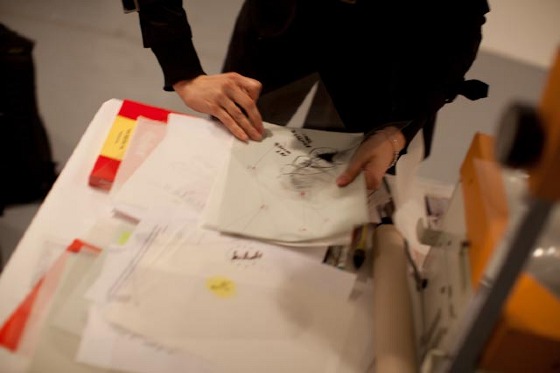
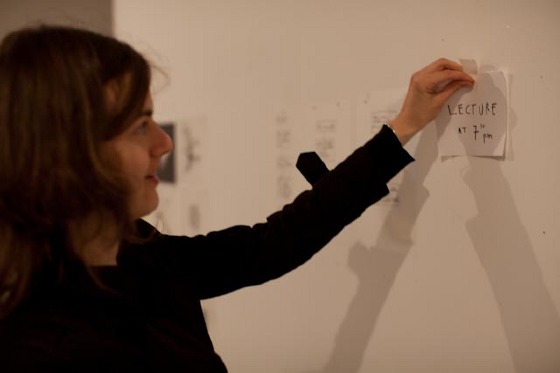 Magda Stanova and Jeremy Akerman
Magda Stanova and Jeremy Akerman
 Jeremy Akerman
Jeremy Akerman
 Magda Stanova and Paul O'Kane
Magda Stanova and Paul O'Kane
 Paul O'Kane
Paul O'Kane
 Thorsten Schneider
Thorsten Schneider

 Product Placement brings together a range of artists and product designers who share an interest in how objects are made, displayed and sold in contemporary culture. The exhibition explores the processes of production and marketing commodities, but on a wider scale, how (and by whom) participation in consumer activity is structured or framed.
Each artist and product designer has been ‘paired’ in order to produce a new object, multiple or edition for the exhibition. Via their cross-disciplinary collaboration, new and combined working processes will be found and explored. The resulting objects (perhaps neither product or artwork) are placed in a specifically constructed installation for the exhibition. Through an architectural re-working of the gallery, the space will become a parody of 'catalogue' stores - mimicking their structure of experience with catalogue kiosks, service point (with uniformed assistant) and market hall/storage space. Merging this structure into the space intends to amplify and question the functional similarities and behavioral prompts of gallery, retail and warehouse spaces.
An accompanying publication will be launched on the opening night.
Further information on the collaborators and the project can be found on the Product Placement Website: www.productandplacement.com/
Supported by
Product Placement brings together a range of artists and product designers who share an interest in how objects are made, displayed and sold in contemporary culture. The exhibition explores the processes of production and marketing commodities, but on a wider scale, how (and by whom) participation in consumer activity is structured or framed.
Each artist and product designer has been ‘paired’ in order to produce a new object, multiple or edition for the exhibition. Via their cross-disciplinary collaboration, new and combined working processes will be found and explored. The resulting objects (perhaps neither product or artwork) are placed in a specifically constructed installation for the exhibition. Through an architectural re-working of the gallery, the space will become a parody of 'catalogue' stores - mimicking their structure of experience with catalogue kiosks, service point (with uniformed assistant) and market hall/storage space. Merging this structure into the space intends to amplify and question the functional similarities and behavioral prompts of gallery, retail and warehouse spaces.
An accompanying publication will be launched on the opening night.
Further information on the collaborators and the project can be found on the Product Placement Website: www.productandplacement.com/
Supported by

 Photographs by Mark Selby and Iavor Lubomirov
Shop front
William Smith
Catalogue Kiosks (2012)
Photographs by Mark Selby and Iavor Lubomirov
Shop front
William Smith
Catalogue Kiosks (2012)

 Shop counter
Rachael Davies
Uniform Allowance (2012)
Felt, thread, tissue and double sided tape
Shop counter
Rachael Davies
Uniform Allowance (2012)
Felt, thread, tissue and double sided tape

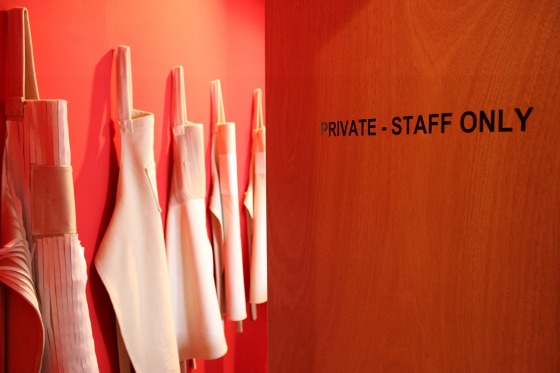

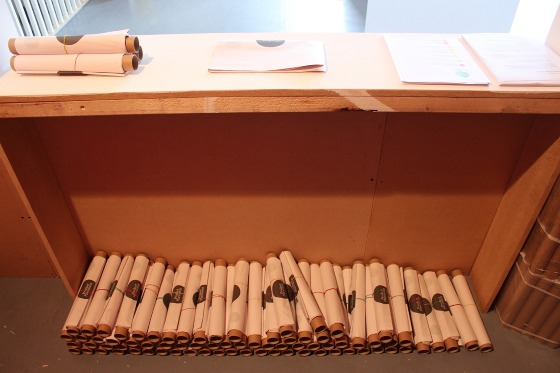 Store room
Installation views
Store room
Installation views

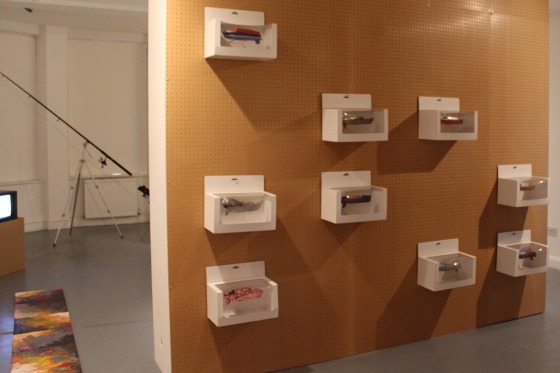
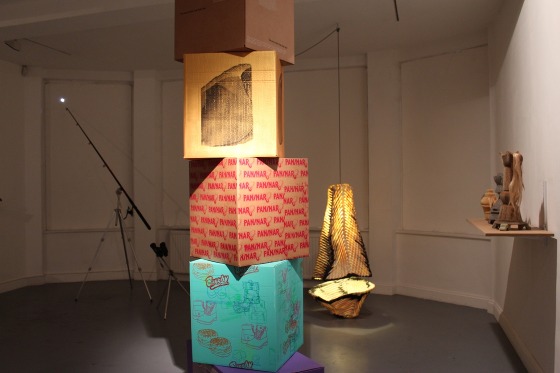

 Products
Gordon Cheung + James Cadogan
Sundial (2012)
Laser cut sheets of glued newspaper (Financial Times)
Products
Gordon Cheung + James Cadogan
Sundial (2012)
Laser cut sheets of glued newspaper (Financial Times)
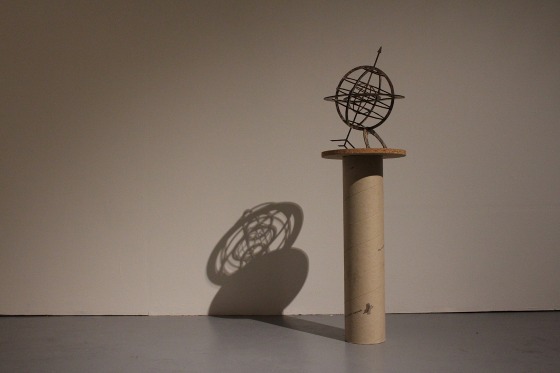
 Irene Alvarez
How To Sculpt an A4 in 67 Pages (2012)
Animated GIF (DVD transfer)
Irene Alvarez
How To Sculpt an A4 in 67 Pages (2012)
Animated GIF (DVD transfer)
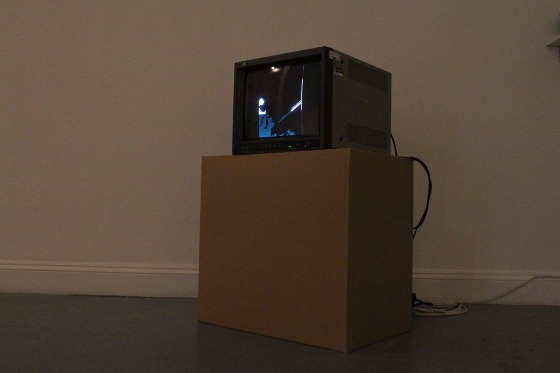
 Rafel Oliva
Sculpting the Landscape (2012)
Tripods, fishing rod, binoculars, sunglasses and Polaroid
Rafel Oliva
Sculpting the Landscape (2012)
Tripods, fishing rod, binoculars, sunglasses and Polaroid
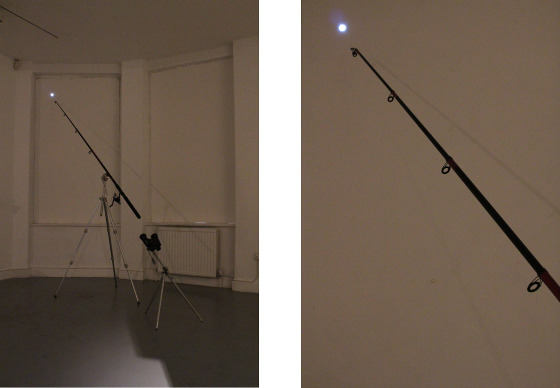
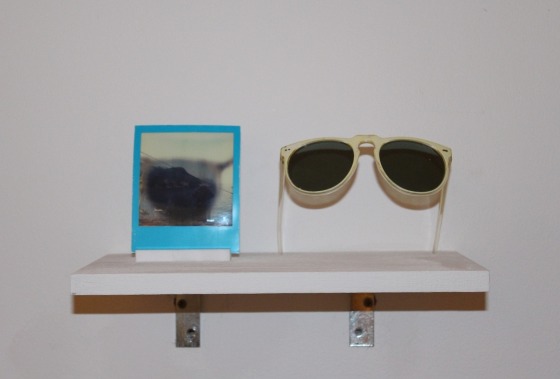 Silo Studio (Oscar Wanless & Attua Aparicio)
Mary and Eliza (2012)
NSEPS polystyrene and polyethylene with disperse heat transfer dye
Silo Studio (Oscar Wanless & Attua Aparicio)
Mary and Eliza (2012)
NSEPS polystyrene and polyethylene with disperse heat transfer dye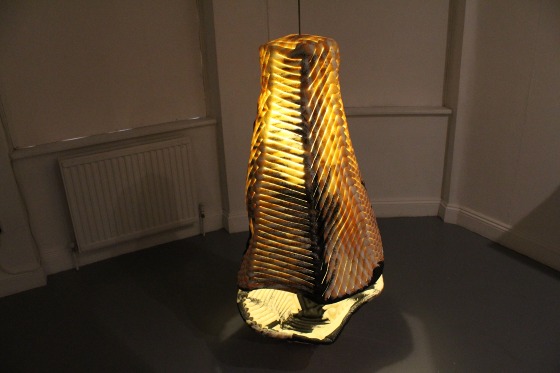
 Corinne Felgate (Factice)
Tenskwatawa, Osceola, Wovoka (2012)
Flocked ceramics and human hair
Corinne Felgate (Factice)
Tenskwatawa, Osceola, Wovoka (2012)
Flocked ceramics and human hair

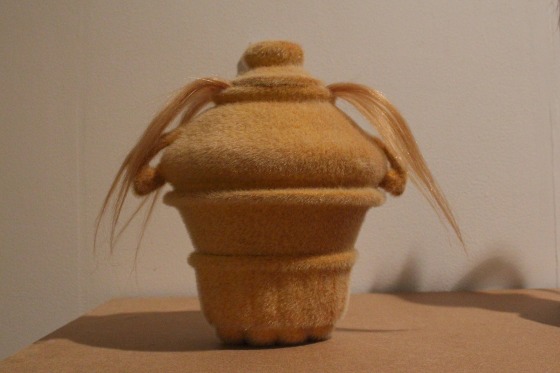
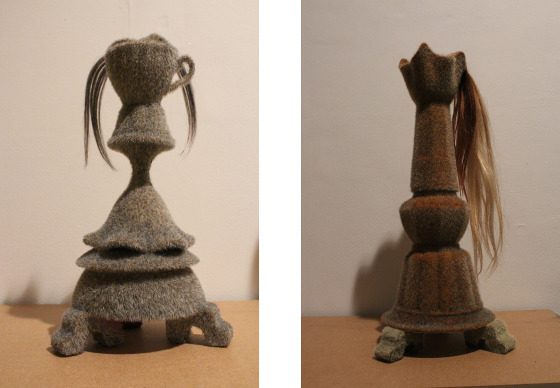 Kim Thome + Alex Chinneck
Wax Tiles (2012)
Melted wax crayons and board
Kim Thome + Alex Chinneck
Wax Tiles (2012)
Melted wax crayons and board
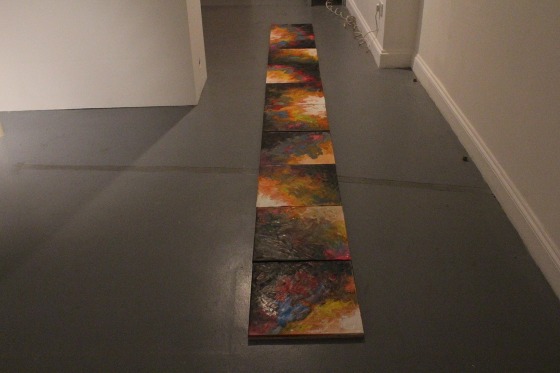
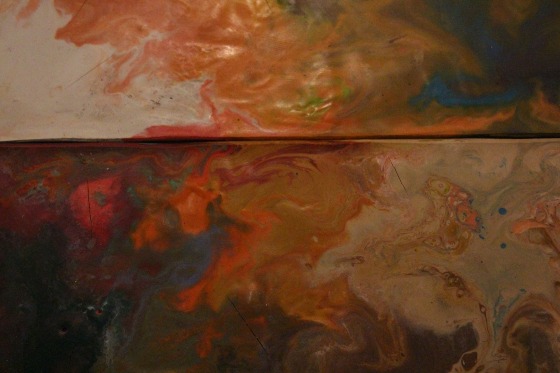 Ludovica Gioscia (Factice)
Pan-Stäck (2012)
Screenprinted cardboard
Ludovica Gioscia (Factice)
Pan-Stäck (2012)
Screenprinted cardboard
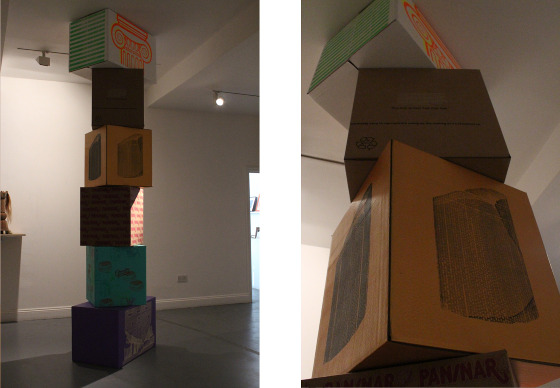
 Harry Meadows + Max Frommeld
Pop-Pop Boats (2012)
Boats produced by students from Bow School
Die-cut cardboard and plastic (Packaging)
Harry Meadows + Max Frommeld
Pop-Pop Boats (2012)
Boats produced by students from Bow School
Die-cut cardboard and plastic (Packaging)

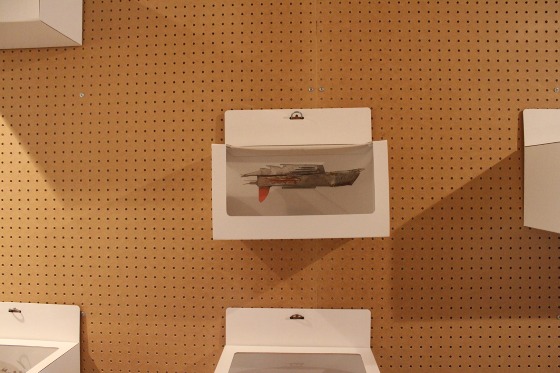
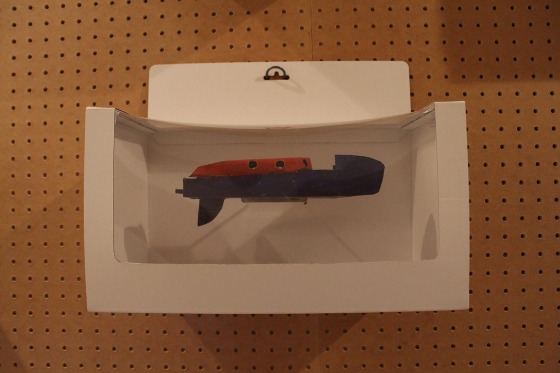
 Richard Cramp + Luke Smith-Wightman
Products 1-5 (2012)
Richard Cramp + Luke Smith-Wightman
Products 1-5 (2012)
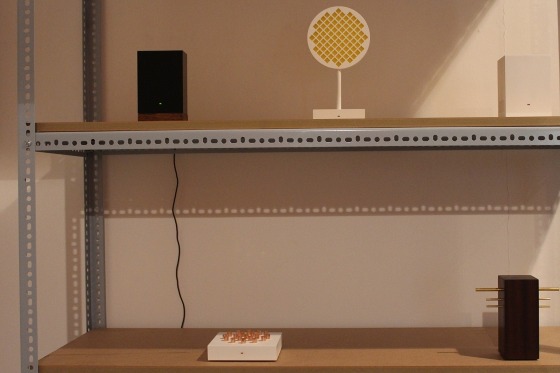
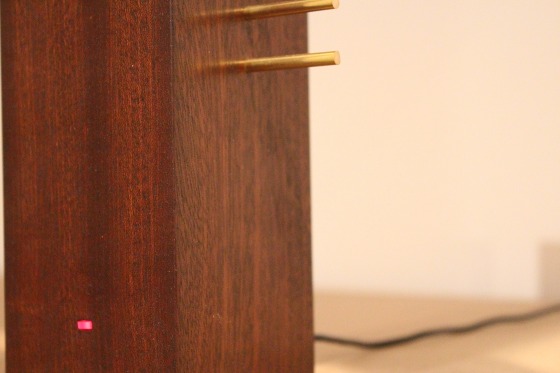
 Like the climax of Shinya Tsukamoto’s 1989 film Tetsuo, from which the exhibition gets its name, 俺たちの愛情で世界中を燃えあがらせてやるぜ。やりまくるぞ。is about merger. In the case of Tetsuo it is between a salaryman and a fetishist; one tied into commerce and corporations, the other a shamanistic punk capable of extraordinary powers of transformation. Perhaps art is locked in a similar conflict between commodity and fetish, a composition of money and magic. Perhaps that's the deal. Or perhaps these forces combine to let an uncanny state of amity emerge from impossible conflicts, a state from which to take apart the world. That was the curatorial proposition. The work in the exhibition may be something different. I am writing this in the summer. It is hot and the Olympics have just come to an end. It is autumn at the exhibition, and the Frieze Art Fair is opening in Regent's Park.
Carlos Noronha Feio (born 1981, in Portugal) completed an MRes (Masters of Research) Arts Practice at the University of the Arts London, an M.A Fine Art at Middlesex University, London and is currently undertaking a PhD at the Royal College of Art, London. He has exhibited and performed widely in the UK and abroad including the Whitechapel Gallery, London; the National Centre for Contemporary Art, Moscow; Navicula Artis, Saint Petersburg; Milton Keynes Gallery, Milton Keynes; Colchester Art Centre, Colchester; Abrons Art Centre, New York; Museu Nogueira da Silva, Braga; Fundação Calouste Gulbenkian and Fundação EDP in Lisbon and Centro cultural Helio Oiticica in Rio de Janeiro.
Flore Nove-Josserand (born 1980, in France) studied at the Slade School of Fine Art and at Ecole Nationale Supérieure d’Art de Paris-Cergy, Cergy, France. She has exhibited in the UK and abroad including at the Siobhan Davies Studio, London; Bischoff/Weiss, London; V22, London; Analix Forever, Geneva and Geflitter+Partner Architecten, Munich. She has undertaken residencies at the Academy of Fine Art of Poznan, Skoki, Poland; Triangle France Residency, La Friche Belle de Mai, Marseille, France; Space, Malinalco, Mexico and most recently at The New Art Gallery Walsall in partnership with Eastside Projects.
Alejandro Ospina (born, 1970 in Colombia) studied at the Slade School of Fine Art, the New York Studio School and Duke University. He has exhibited widely in the UK and the Americas including The Creekside Open selected by Victoria Miro; Paradise Row, London; Witzenhausen Gallery, New York; Nuevos Nombres (Luis Angel Arango), Centro Cultural Salamanca and Christopher Paschall XX21 Gallery, Bogota.
NaoKo TakaHashi (born 1973 in Japan) studied at the Slade School of Fine Art and Chelsea College of Art and Design, London. She has exhibited and performed widely in the UK, Europe and the Middle East including Tate Modern, London; the Palais de Tokyo, Paris; the Whitechapel Gallery, London; the Centre for Contemporary Art, Glasgow; Riso Museo d’arte Contemporanea Della Sicilia, Palermo; Nikolaj Copenhagen Contemporary Art Centre, Copenhagen; Bozar, Brussels; Darat Al Funun, The Khalid Showman Foundation, Amman, Jordan; Al Ma’mal Foundation for contemporary Art, Jerusalem; the 3rd Thessaloniki Biennale of Contemporary Art, Greece, and in the first major trilingual biennale in North Africa, the 3rd AiM International Biennale, Marrakesh.
mail@imagemusictext.com
www.imagemusictext.com/
Photographs by Iavor Lubomirov
Alejandro Ospina
The Brazilian Golddiggers and the American One-legged Sportsman
2012
Oil on Canvas
Like the climax of Shinya Tsukamoto’s 1989 film Tetsuo, from which the exhibition gets its name, 俺たちの愛情で世界中を燃えあがらせてやるぜ。やりまくるぞ。is about merger. In the case of Tetsuo it is between a salaryman and a fetishist; one tied into commerce and corporations, the other a shamanistic punk capable of extraordinary powers of transformation. Perhaps art is locked in a similar conflict between commodity and fetish, a composition of money and magic. Perhaps that's the deal. Or perhaps these forces combine to let an uncanny state of amity emerge from impossible conflicts, a state from which to take apart the world. That was the curatorial proposition. The work in the exhibition may be something different. I am writing this in the summer. It is hot and the Olympics have just come to an end. It is autumn at the exhibition, and the Frieze Art Fair is opening in Regent's Park.
Carlos Noronha Feio (born 1981, in Portugal) completed an MRes (Masters of Research) Arts Practice at the University of the Arts London, an M.A Fine Art at Middlesex University, London and is currently undertaking a PhD at the Royal College of Art, London. He has exhibited and performed widely in the UK and abroad including the Whitechapel Gallery, London; the National Centre for Contemporary Art, Moscow; Navicula Artis, Saint Petersburg; Milton Keynes Gallery, Milton Keynes; Colchester Art Centre, Colchester; Abrons Art Centre, New York; Museu Nogueira da Silva, Braga; Fundação Calouste Gulbenkian and Fundação EDP in Lisbon and Centro cultural Helio Oiticica in Rio de Janeiro.
Flore Nove-Josserand (born 1980, in France) studied at the Slade School of Fine Art and at Ecole Nationale Supérieure d’Art de Paris-Cergy, Cergy, France. She has exhibited in the UK and abroad including at the Siobhan Davies Studio, London; Bischoff/Weiss, London; V22, London; Analix Forever, Geneva and Geflitter+Partner Architecten, Munich. She has undertaken residencies at the Academy of Fine Art of Poznan, Skoki, Poland; Triangle France Residency, La Friche Belle de Mai, Marseille, France; Space, Malinalco, Mexico and most recently at The New Art Gallery Walsall in partnership with Eastside Projects.
Alejandro Ospina (born, 1970 in Colombia) studied at the Slade School of Fine Art, the New York Studio School and Duke University. He has exhibited widely in the UK and the Americas including The Creekside Open selected by Victoria Miro; Paradise Row, London; Witzenhausen Gallery, New York; Nuevos Nombres (Luis Angel Arango), Centro Cultural Salamanca and Christopher Paschall XX21 Gallery, Bogota.
NaoKo TakaHashi (born 1973 in Japan) studied at the Slade School of Fine Art and Chelsea College of Art and Design, London. She has exhibited and performed widely in the UK, Europe and the Middle East including Tate Modern, London; the Palais de Tokyo, Paris; the Whitechapel Gallery, London; the Centre for Contemporary Art, Glasgow; Riso Museo d’arte Contemporanea Della Sicilia, Palermo; Nikolaj Copenhagen Contemporary Art Centre, Copenhagen; Bozar, Brussels; Darat Al Funun, The Khalid Showman Foundation, Amman, Jordan; Al Ma’mal Foundation for contemporary Art, Jerusalem; the 3rd Thessaloniki Biennale of Contemporary Art, Greece, and in the first major trilingual biennale in North Africa, the 3rd AiM International Biennale, Marrakesh.
mail@imagemusictext.com
www.imagemusictext.com/
Photographs by Iavor Lubomirov
Alejandro Ospina
The Brazilian Golddiggers and the American One-legged Sportsman
2012
Oil on Canvas
 Alejandro Ospina
The Flood and the Magic Wand
2012
Oil on Canvas
Alejandro Ospina
The Flood and the Magic Wand
2012
Oil on Canvas
 Flore Nove-Josserand
Reclining Bird
2012
Mixed media
Flore Nove-Josserand
Reclining Bird
2012
Mixed media

 Alejandro Ospina
The Flood and the Magic Wand
Carlos Noronha Feio
There Are Always More Worlds Beyond the New Ones (Birth and Fertility; Wheel of Desitny; Power; Good News)
2010
Arraiolos rug
Alejandro Ospina
The Flood and the Magic Wand
Carlos Noronha Feio
There Are Always More Worlds Beyond the New Ones (Birth and Fertility; Wheel of Desitny; Power; Good News)
2010
Arraiolos rug

 Flore Nove-Josserand
Plateau
2012
Mixed media
Flore Nove-Josserand
Creamy Dawn
2012
Wallpaper
Alejandro Ospina
The Brazilian Golddiggers and the American One-legged Sportsman
Flore Nove-Josserand
B.I.S.
2012
Mixed media
Flore Nove-Josserand
Plateau
2012
Mixed media
Flore Nove-Josserand
Creamy Dawn
2012
Wallpaper
Alejandro Ospina
The Brazilian Golddiggers and the American One-legged Sportsman
Flore Nove-Josserand
B.I.S.
2012
Mixed media


 Alejandro Ospina
Barrio Motin / Yeime's Sky
2012
Oil on canvas
Flore Nove-Josserand
Plateau
2012
Mixed media
Alejandro Ospina
Barrio Motin / Yeime's Sky
2012
Oil on canvas
Flore Nove-Josserand
Plateau
2012
Mixed media


 Flore Nove-Josserand
Creamy Dawn
2012
Wallpaper
Alejandro Ospina
The Brazilian Golddiggers and the American One-legged Sportsman
Flore Nove-Josserand
Reclining Bird
2012
Mixed media
Flore Nove-Josserand
Creamy Dawn
2012
Wallpaper
Alejandro Ospina
The Brazilian Golddiggers and the American One-legged Sportsman
Flore Nove-Josserand
Reclining Bird
2012
Mixed media
 Naoko TakaHashi
Repetition of Uncoded
2012
Mixed media installation with video
Video commissioned for POLYply, London P.O.A
Naoko TakaHashi
Repetition of Uncoded
2012
Mixed media installation with video
Video commissioned for POLYply, London P.O.A
 Naoko TakaHashi
False Awakening of the Alienation
2012
Mixed media with fabric, wristbands, stepladder and drawing
Naoko TakaHashi
False Awakening of the Alienation
2012
Mixed media with fabric, wristbands, stepladder and drawing
 Installation Views
Installation Views


 Gary Beydler, "Venice Pier", 1976
Sheffield Fringe and Angus-Hughes Gallery are pleased to present an evening of films selected by Los Angeles Filmforum's Adam Hyman. The programme includes recently rediscovered films previously unseen in the UK alongside contemporary works that reframe the recent past and explore the kaleidoscopic expanse of Los Angeles’ geography.
Urban Observations – Los Angeles uncovers how alternate visions of Los Angeles were forged by multiple generations of experimental filmmakers. All these works are non-fiction, but none fit common documentary modes. How does one see the many facets of any city, and what are some of the possibilities of conveying those observations through film?
Two portraits of markets in different parts of the city have different objectives. Grand Central Market, directed by William Hale and photographed by Haskell Wexler for the US Information Agency in 1963 propagates without commentary the harmonious mingling of races in downtown Los Angeles.
Shoppers Market - a recently rediscovered masterpiece made in the same year by John Vicario whilst he was still a student at UCLA - casts a playfully critical glance at supermarket shopping. As Ken Eisenstein points out, Vicario’s sound design gives pleasure to our ears; by far the more sensitive in the cinematic experience.
The diversity of different visions of the LA cityscape is further revealed via a meditation on the last drive-in movie theatre in Los Angeles in Laura Kraning’s film Vineland (2009), “serving as an emblematic space, where a collision of realities takes place”.
Glimpses of the city from buses and their denizens create the backdrop to isolation, routine and everyday splendor as described by Alexandra Cuesta in her film Piensa En Mi (2009). And a latent history of the birth of the Jet Propulsion Laboratory and the occult is explored in Devil’s Gate (2011), again by Laura Kraning.
Finally Venice Pier, Gary Beydler’s film from 1976, is a conceptual masterpiece and a ‘cinematic walk’ on Venice Pier, majestically documenting the course of a whole year.
Adam Hyman is a documentary filmmaker and executive Director for Los Angeles Filmforum, the longest-running showcase for independent, experimental and progressive moving-image art in Southern California. lafilmforum.org. This programme was first screened on 15 June 2012 at the Void Cinema, Sheffield Hallam University as part of Sheffield Fringe. Supported by Los Angeles Filmforum, Canyon Cinema and Goldsmiths College.
Sheffield Fringe is an artist-led curatorial project exploring the intersection of art & documentary practices, through screenings, talks, exhibitions and research, presented in partnership with Openvizor. Openvizor is a UK based non-profit arts and cultural organisation fostering collaborations through projects with individual artists, local communities, activists, and institutions around the world.
For further information and artist biographies please visit sheffieldfringe.com
Gary Beydler, "Venice Pier", 1976
Sheffield Fringe and Angus-Hughes Gallery are pleased to present an evening of films selected by Los Angeles Filmforum's Adam Hyman. The programme includes recently rediscovered films previously unseen in the UK alongside contemporary works that reframe the recent past and explore the kaleidoscopic expanse of Los Angeles’ geography.
Urban Observations – Los Angeles uncovers how alternate visions of Los Angeles were forged by multiple generations of experimental filmmakers. All these works are non-fiction, but none fit common documentary modes. How does one see the many facets of any city, and what are some of the possibilities of conveying those observations through film?
Two portraits of markets in different parts of the city have different objectives. Grand Central Market, directed by William Hale and photographed by Haskell Wexler for the US Information Agency in 1963 propagates without commentary the harmonious mingling of races in downtown Los Angeles.
Shoppers Market - a recently rediscovered masterpiece made in the same year by John Vicario whilst he was still a student at UCLA - casts a playfully critical glance at supermarket shopping. As Ken Eisenstein points out, Vicario’s sound design gives pleasure to our ears; by far the more sensitive in the cinematic experience.
The diversity of different visions of the LA cityscape is further revealed via a meditation on the last drive-in movie theatre in Los Angeles in Laura Kraning’s film Vineland (2009), “serving as an emblematic space, where a collision of realities takes place”.
Glimpses of the city from buses and their denizens create the backdrop to isolation, routine and everyday splendor as described by Alexandra Cuesta in her film Piensa En Mi (2009). And a latent history of the birth of the Jet Propulsion Laboratory and the occult is explored in Devil’s Gate (2011), again by Laura Kraning.
Finally Venice Pier, Gary Beydler’s film from 1976, is a conceptual masterpiece and a ‘cinematic walk’ on Venice Pier, majestically documenting the course of a whole year.
Adam Hyman is a documentary filmmaker and executive Director for Los Angeles Filmforum, the longest-running showcase for independent, experimental and progressive moving-image art in Southern California. lafilmforum.org. This programme was first screened on 15 June 2012 at the Void Cinema, Sheffield Hallam University as part of Sheffield Fringe. Supported by Los Angeles Filmforum, Canyon Cinema and Goldsmiths College.
Sheffield Fringe is an artist-led curatorial project exploring the intersection of art & documentary practices, through screenings, talks, exhibitions and research, presented in partnership with Openvizor. Openvizor is a UK based non-profit arts and cultural organisation fostering collaborations through projects with individual artists, local communities, activists, and institutions around the world.
For further information and artist biographies please visit sheffieldfringe.com
 New works by Hanz Hancock, Sayshun Jay and Patrick Morrissey
Hanz Hancock has worked recently in close proximity to Morrissey on a number of projects. Hancocks work is preoccupied by experimentation with multiples within a grid. The works, which are seemingly 2D,ultimately register their subtle three dimensionality in the form of kinetic exchange which occurs with the viewer. Both artists work may be said to have many concerns, notwithstanding the physiological aspects of perception, and are intensely wrought to induce meditative contemplation/ physiological response
Sayshun Jay makes constrained videos. His sculpture combines experimental videos placing chaos and noise into a relationship with tone and emptiness.
Patrick Morrissey is a multi-disciplinary artist who works from a filmic aesthetic. His practice moves between painting and installation via film, and for this show, he presents a series of paintings whose formal abstraction provides a vehicle for the exploration of numeric/ geometric systems which aggregate to form kinetic mass in a series of statements . Morrissey’ practice, demonstrates some of the concomitant attributes of international Reductivism. The use of systems , geometric composition/elements, repetition, random intervention and elimination, are all utilised.
Photographs by Sayshun Jay and Patrick Morrissey.
New works by Hanz Hancock, Sayshun Jay and Patrick Morrissey
Hanz Hancock has worked recently in close proximity to Morrissey on a number of projects. Hancocks work is preoccupied by experimentation with multiples within a grid. The works, which are seemingly 2D,ultimately register their subtle three dimensionality in the form of kinetic exchange which occurs with the viewer. Both artists work may be said to have many concerns, notwithstanding the physiological aspects of perception, and are intensely wrought to induce meditative contemplation/ physiological response
Sayshun Jay makes constrained videos. His sculpture combines experimental videos placing chaos and noise into a relationship with tone and emptiness.
Patrick Morrissey is a multi-disciplinary artist who works from a filmic aesthetic. His practice moves between painting and installation via film, and for this show, he presents a series of paintings whose formal abstraction provides a vehicle for the exploration of numeric/ geometric systems which aggregate to form kinetic mass in a series of statements . Morrissey’ practice, demonstrates some of the concomitant attributes of international Reductivism. The use of systems , geometric composition/elements, repetition, random intervention and elimination, are all utilised.
Photographs by Sayshun Jay and Patrick Morrissey.


 All rights reserved. Please contact mail@angus-hughes.com if you intend to use any of these images.
All rights reserved. Please contact mail@angus-hughes.com if you intend to use any of these images.
 At the Edges brings together the work of four artists that explore shifting visions of the landscape and the discourse around how these images are experienced.
Taking into consideration the nature of representation as much as the representation of nature, the works investigate the mediated image of the landscape, addressing the relationship between the actual and the imagined across combinations of images and objects.
Presented in the exhibition are interconnected depictions of the natural world; a collection of fictions that weave idyllic, familiar and dystopian visions, through models of conscious fabrication, that together inquire into our relationship to our environment.
Hannah Brown’s paintings and sculptures draw on the omnipresent legacy of the English landscape tradition. Working within and against this framework she presents carefully edited interpretations of seemingly bucolic scenes. Her oil paintings depict versions of our landscape, emptied of people and obvious signs of life, under a familiar flat grey English light. Her sculptures function as physically present motifs that refer back to the paintings and the tradition of idealized versions of nature manufactured for domestic display.
Gary Colclough’s works consider the act of looking, and how looking relates to understanding. His sculptures present hand-drawn images within spatial and temporal arrangements that mediate the viewers’ experience of the image. Drawing on references to the Arts and Craft furniture, esoteric geometry, and optical contraptions, his diagrammatic structures function as both as spatial sculptures and presentation devices for drawings. The images in his work, meticulously rendered in coloured pencil, explore the allure of the depiction of nature, through the evocation of early natural history illustrations.
Boo Ritson’s recent sculptural works, explore vistas of romantic American landscapes, filtered through references to constructed environments that draw on photography, collage and landscape painting. Simultaneously functioning as images and object, Ritson’s constructions are collaged from pictures originally taken at her home in Chesham; the American picturesque filtered through a very British lens. Her works often take on the appearance of artificial environments that populate video games and virtual reality. Fabricated landscapes, both familiar and slightly ominous, create settings in which the unknown may manifest.
Jane Ward’s images of imaginary and transient landscapes are at once both familiar and disturbing. They are constructed from digital photographs, which have been repeatedly broken down and collaged, printed and then manipulated by hand. The images bear the traces of earlier actions and forms, imbuing the works with a sense of memory and the passage of time. Ward’s working process and the resultant images allude to the cycles of destruction and regeneration witnessed in our everyday surroundings.
At the Edges is accompanied by a publication featuring an essay by Graham Crowley.
Photographs by Nancy Elser
Installation Views
At the Edges brings together the work of four artists that explore shifting visions of the landscape and the discourse around how these images are experienced.
Taking into consideration the nature of representation as much as the representation of nature, the works investigate the mediated image of the landscape, addressing the relationship between the actual and the imagined across combinations of images and objects.
Presented in the exhibition are interconnected depictions of the natural world; a collection of fictions that weave idyllic, familiar and dystopian visions, through models of conscious fabrication, that together inquire into our relationship to our environment.
Hannah Brown’s paintings and sculptures draw on the omnipresent legacy of the English landscape tradition. Working within and against this framework she presents carefully edited interpretations of seemingly bucolic scenes. Her oil paintings depict versions of our landscape, emptied of people and obvious signs of life, under a familiar flat grey English light. Her sculptures function as physically present motifs that refer back to the paintings and the tradition of idealized versions of nature manufactured for domestic display.
Gary Colclough’s works consider the act of looking, and how looking relates to understanding. His sculptures present hand-drawn images within spatial and temporal arrangements that mediate the viewers’ experience of the image. Drawing on references to the Arts and Craft furniture, esoteric geometry, and optical contraptions, his diagrammatic structures function as both as spatial sculptures and presentation devices for drawings. The images in his work, meticulously rendered in coloured pencil, explore the allure of the depiction of nature, through the evocation of early natural history illustrations.
Boo Ritson’s recent sculptural works, explore vistas of romantic American landscapes, filtered through references to constructed environments that draw on photography, collage and landscape painting. Simultaneously functioning as images and object, Ritson’s constructions are collaged from pictures originally taken at her home in Chesham; the American picturesque filtered through a very British lens. Her works often take on the appearance of artificial environments that populate video games and virtual reality. Fabricated landscapes, both familiar and slightly ominous, create settings in which the unknown may manifest.
Jane Ward’s images of imaginary and transient landscapes are at once both familiar and disturbing. They are constructed from digital photographs, which have been repeatedly broken down and collaged, printed and then manipulated by hand. The images bear the traces of earlier actions and forms, imbuing the works with a sense of memory and the passage of time. Ward’s working process and the resultant images allude to the cycles of destruction and regeneration witnessed in our everyday surroundings.
At the Edges is accompanied by a publication featuring an essay by Graham Crowley.
Photographs by Nancy Elser
Installation Views



 Hannah Brown
Hannah Brown



 Gary Colclough
Gary Colclough




 Boo Ritson
Boo Ritson
 Jane Ward
Jane Ward

 All rights reserved. Please contact nancy@alisn.org for premission if you intend to use any of these images
All rights reserved. Please contact nancy@alisn.org for premission if you intend to use any of these images
 "The point of this show is to speak about the concept, the make-up, the visibility, the internal/external substance that is tied to being male. The male presence is prevalent in the world, but its meaning is not open for discussion, other than on the level of divisions as being chauvinists and war mongers. The language simply does not exist. Too much focus has been made about the differences between the sexes, why not point out our sameness, what we have in common, rather than a boy and girl teenage scenario of who’s better.
The dysfunction of the contemporary male seems a universal condemnation, he is bound by his own history.
The work presented, stands apart from who has made it, in the sense that the voice of female, male, heterosexual, homosexual, lesbian or trans gender is not a specific issue. All the work is about the acknowledgement of the peripheries that are a part of masculine identity, for no other reason than that it may be of interest and might toy with some other insights. Freedom is about being allowed to be yourself, as whoever you wish to see yourself as. Being male or female should not be a competition, it is about our similarities, and our different needs. We have a lot of common ground, we must stop buying into the games that society and culture have set for us.
The show hopefully has a certain understood surface, but has depth if you wish to dig deeper. It is not meant to be conclusive but merely a starting point. I for one am fed up with meeting broken people – and for what - other than bourgeoisie media, stereotype garbage which pushes values of how you are meant to be.
This show is about opening up, not closing down conversations – the building of a dialogue, to move forward towards a shared empathy between each other."
- William Angus-Hughes
"The point of this show is to speak about the concept, the make-up, the visibility, the internal/external substance that is tied to being male. The male presence is prevalent in the world, but its meaning is not open for discussion, other than on the level of divisions as being chauvinists and war mongers. The language simply does not exist. Too much focus has been made about the differences between the sexes, why not point out our sameness, what we have in common, rather than a boy and girl teenage scenario of who’s better.
The dysfunction of the contemporary male seems a universal condemnation, he is bound by his own history.
The work presented, stands apart from who has made it, in the sense that the voice of female, male, heterosexual, homosexual, lesbian or trans gender is not a specific issue. All the work is about the acknowledgement of the peripheries that are a part of masculine identity, for no other reason than that it may be of interest and might toy with some other insights. Freedom is about being allowed to be yourself, as whoever you wish to see yourself as. Being male or female should not be a competition, it is about our similarities, and our different needs. We have a lot of common ground, we must stop buying into the games that society and culture have set for us.
The show hopefully has a certain understood surface, but has depth if you wish to dig deeper. It is not meant to be conclusive but merely a starting point. I for one am fed up with meeting broken people – and for what - other than bourgeoisie media, stereotype garbage which pushes values of how you are meant to be.
This show is about opening up, not closing down conversations – the building of a dialogue, to move forward towards a shared empathy between each other."
- William Angus-Hughes
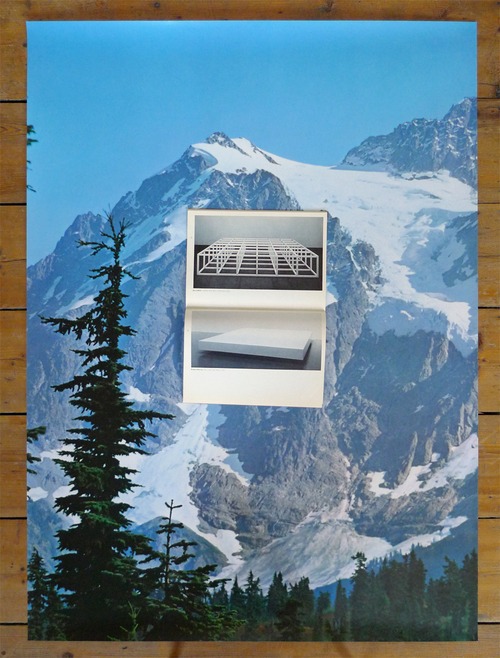 Julia Crabtree & William Evans
Timothy Ivison & Julia Tcharfas
Maria Theodoraki with John Smith
Maria Theodoraki with Jamie George
An exhibition which explores the nature of collaboration through three varying practices.
In the spirit of the continued collaboration between Angus-Hughes Gallery and curators/collectives/projects/artists, the gesamtkunstwerk* project presents an exhibition which explores the nature of collaboration through three varying practices. The two collaborative pairs will be exhibiting contrasting installations, whilst the third practice of Theodoraki explores different modes of working together—with places, objects and other people, artists, or curators.
Also presented in this collaborative exhibition is the TOTAL ART BOX. This box, which has roots in the ‘Fluxbox’ ‘s from the Fluxus movement, contains the work of artists involved in the project. In a box which has been custom designed and constructed by Surya Buck, the contents of this first edition of 50 will be displayed in the gallery.
*The gesamtkunstwerk project brings together international artists, musicians, writers, photographers, filmmakers, and curators that will journey across the United States in 2012, putting on exhibitions, gigs, talks and events. From the west to east coast the project in itself will be a total artwork. The term gesamtkunstwerk has been appropriated here, using its literal translation total artwork, for the purpose of describing this group of artists and their actions. From 2010 a series of exhibitions, events, gigs and talks are being presented in the UK to raise the profile of the event and it’s purpose to promote international exchange across multiple disciplines.
Curated by Corinne Mynatt for gesamtkunstwerk 2012.
http://www.gesamtkunstwerk2012.co.uk/
gesamtkunstwerk2012@gmail.com / 07931 439 942
Poster image: By the principle of eternal progression in which there is an endlessly creative unfoldment manifested successively in potentially countless forms, 2010. By Tim Ivison and Julia Tcharfas
Installation View:
Julia Crabtree & William Evans
Timothy Ivison & Julia Tcharfas
Maria Theodoraki with John Smith
Maria Theodoraki with Jamie George
An exhibition which explores the nature of collaboration through three varying practices.
In the spirit of the continued collaboration between Angus-Hughes Gallery and curators/collectives/projects/artists, the gesamtkunstwerk* project presents an exhibition which explores the nature of collaboration through three varying practices. The two collaborative pairs will be exhibiting contrasting installations, whilst the third practice of Theodoraki explores different modes of working together—with places, objects and other people, artists, or curators.
Also presented in this collaborative exhibition is the TOTAL ART BOX. This box, which has roots in the ‘Fluxbox’ ‘s from the Fluxus movement, contains the work of artists involved in the project. In a box which has been custom designed and constructed by Surya Buck, the contents of this first edition of 50 will be displayed in the gallery.
*The gesamtkunstwerk project brings together international artists, musicians, writers, photographers, filmmakers, and curators that will journey across the United States in 2012, putting on exhibitions, gigs, talks and events. From the west to east coast the project in itself will be a total artwork. The term gesamtkunstwerk has been appropriated here, using its literal translation total artwork, for the purpose of describing this group of artists and their actions. From 2010 a series of exhibitions, events, gigs and talks are being presented in the UK to raise the profile of the event and it’s purpose to promote international exchange across multiple disciplines.
Curated by Corinne Mynatt for gesamtkunstwerk 2012.
http://www.gesamtkunstwerk2012.co.uk/
gesamtkunstwerk2012@gmail.com / 07931 439 942
Poster image: By the principle of eternal progression in which there is an endlessly creative unfoldment manifested successively in potentially countless forms, 2010. By Tim Ivison and Julia Tcharfas
Installation View:



 All photographs by Nancy Elser and Iavor Lubomirov
All photographs by Nancy Elser and Iavor Lubomirov
 Isha Bohling – Mandy Hudson – Paul O’Kane – Nobuko Tsuchiya
Somewhere between the found object and the ready-made, between the image and paint, or between the photographic and the archive, lies a territory that exits between nostalgia and displacement. It is into this uncertain space that this exhibition tentatively treads. The art here, through the suggestion of narrative, locate a certain longing within the everyday. In that respect, it is as souvenir that we experience what is both within, and is common to, these works. “The delicate and hermetic world of the souvenir is a world of nature idealised; nature is removed from the domain of struggle into the domestic sphere … “. Thus Susan Stewart once suggested souvenirs, like nostalgia, might be virtuous. But the work in Souvenirs shuns sentiment and sympathy while appealing to a life from which it has been separated. This reveals memory to be as unreliable as any souvenir is an inaccurate representative of the past. So souvenirs, like orphans, are left to talk to other times of fateful struggles, serving as sites of reluctant surrender, signs of all that remains of all that has passed.
Isha Bohling’s work reveals or re-imagines untold narratives, recovering past resonances, whilst searching for structures, histories and underlying patterns. It becomes a process of excavation that manifests itself through drawing with object, sound, video, painting music and songs that the artist writes and performs. Outdated everyday objects are transformed into musical instruments and surfaces to project upon, often forming a feedback loop in which the object becomes the instrument that both contains and generates the sound work. Bøhling recuperates fragments of possible narratives surrounding the history of the chosen items.
Mandy Hudson’s paintings are small in scale and are based on details of found arrangements that are part of everyday life. "I am always looking out for subjects that I feel will be interesting to paint taking photographs as reference. This usually results in something between figuration and abstraction, depending on the memory of the subject and the direction the painting takes. A lot of the subjects I choose have a sense of impermanence and vulnerability, and I hope that by painting them I am in someway preserving them."
Paul O’Kane’s visual practice has become increasingly curious about the photographic, filmed and scanned image. Over a 30-year period he has cultivated an archive of his own images, allowing a kind of casino mechanism to throw up anachronisms that speak to the present at fortuitous moments. The photographic image’s emotive invocation of shared time or history has its own history, which Paul the artist sees as a conversation between various notions of the real, technology and materiality.
Nobuko Tsuchiya states: “Not everything is as it appears in my work, not everything is done on purpose. My decisions are made by using what you could call a different form of thinking, and are made to operate between harmony and discord, control and the lack of it. I always try to develop the conversation between the things in my work and myself”.
Nobuko Tsuchiya appears courtesy of Anthony Reynolds Gallery.
Fieldgate Gallery
07957 228351 / fieldgategallery@gmail.com / www.fieldgategallery.com
Isha Bohling
Isha Bohling – Mandy Hudson – Paul O’Kane – Nobuko Tsuchiya
Somewhere between the found object and the ready-made, between the image and paint, or between the photographic and the archive, lies a territory that exits between nostalgia and displacement. It is into this uncertain space that this exhibition tentatively treads. The art here, through the suggestion of narrative, locate a certain longing within the everyday. In that respect, it is as souvenir that we experience what is both within, and is common to, these works. “The delicate and hermetic world of the souvenir is a world of nature idealised; nature is removed from the domain of struggle into the domestic sphere … “. Thus Susan Stewart once suggested souvenirs, like nostalgia, might be virtuous. But the work in Souvenirs shuns sentiment and sympathy while appealing to a life from which it has been separated. This reveals memory to be as unreliable as any souvenir is an inaccurate representative of the past. So souvenirs, like orphans, are left to talk to other times of fateful struggles, serving as sites of reluctant surrender, signs of all that remains of all that has passed.
Isha Bohling’s work reveals or re-imagines untold narratives, recovering past resonances, whilst searching for structures, histories and underlying patterns. It becomes a process of excavation that manifests itself through drawing with object, sound, video, painting music and songs that the artist writes and performs. Outdated everyday objects are transformed into musical instruments and surfaces to project upon, often forming a feedback loop in which the object becomes the instrument that both contains and generates the sound work. Bøhling recuperates fragments of possible narratives surrounding the history of the chosen items.
Mandy Hudson’s paintings are small in scale and are based on details of found arrangements that are part of everyday life. "I am always looking out for subjects that I feel will be interesting to paint taking photographs as reference. This usually results in something between figuration and abstraction, depending on the memory of the subject and the direction the painting takes. A lot of the subjects I choose have a sense of impermanence and vulnerability, and I hope that by painting them I am in someway preserving them."
Paul O’Kane’s visual practice has become increasingly curious about the photographic, filmed and scanned image. Over a 30-year period he has cultivated an archive of his own images, allowing a kind of casino mechanism to throw up anachronisms that speak to the present at fortuitous moments. The photographic image’s emotive invocation of shared time or history has its own history, which Paul the artist sees as a conversation between various notions of the real, technology and materiality.
Nobuko Tsuchiya states: “Not everything is as it appears in my work, not everything is done on purpose. My decisions are made by using what you could call a different form of thinking, and are made to operate between harmony and discord, control and the lack of it. I always try to develop the conversation between the things in my work and myself”.
Nobuko Tsuchiya appears courtesy of Anthony Reynolds Gallery.
Fieldgate Gallery
07957 228351 / fieldgategallery@gmail.com / www.fieldgategallery.com
Isha Bohling



 Mandy Hudson
Mandy Hudson






 Paul O’Kane
Paul O’Kane


 Nobuko Tsuchiya
Nobuko Tsuchiya



 Tower Hamlets Spring Open is a survey of the large and diverse artist community living or working in the borough of Tower Hamlets. Held in the 5000sqft Mile End Art Pavilion, the exhibition is selected and curated by Iavor Lubomirov and Anna Bleeker of ALISN, William Hughes of Angus-Hughes Gallery, Charlie Dutton of Charlie Dutton Gallery, and Paul Good and Kirsty Wood of SHIFT.
ALISN invited artists living or working in Tower Hamlets to submit work with a particular emphasis on large-scale ambitious projects, sculptures, or installations in all mediums, including performance, video, sound and photography. The resulting selection reveals a range of unexpected undercurrents, with much of the work resonating particularly with the architecture of the borough and the gallery.
Christina Mitrentse is a Greek artist, living and working in London, with a studio in Tower Hamlets. She took her MA at Chelsea in 2004. Her work has been included in public and private international collections, including the Tate Archive, the Greenwich Heritage Museum, the Zabludowicz Foundation and the Onassis Foundation. Mitrentse’s sculpture at the Pavilion, ‘Beethoven versus Mozart’, is part of an on-going project ‘Add to my Library’, in which books from her collection are Twisted and stuck together to create organic, yet architectural structures of small scale ‘Podiums’, ‘Tombs’, ‘Plinths’ and ‘Bibliophile’ collages or Fungies.
Eve Allen is currently completing her Fine Art BA at Saint Martins. Her work uses and reuses photographs of domestic interiors and fragments of buildings as source material for evoking memory and a sense of the uncanny inherent in represented space. Her print work, ‘Staircase Going Down’, at the Pavilion, relates to architectures that don't fulfil their function and undermine what they are supposed to be.
Gareth Barnett is currently completing his MA at Saint Martins, having moved to Tower Hamlets from Birmingham. Quoting references such as Conrad Jameson’s branding of modern architects as 'war criminals', Gareth engages Brutalist Dystopia as the setting of the perfect horror film. His 16 panel, 70sqft, wall piece from the series ‘Brut Camp’ explores feelings of control and domination within the urban environment. It is made from a mixture of pencil drawing, xeroxed drawings and concrete rubbings taken from the Balfron Estate in East London, a original Brutalist site designed by Erno Goldfinger.
Harry Meadows took his MFA at Goldsmiths in 2007 and has since shown at the Barbican, the BBC Big Screens and the Royal Festival Hall. Meadows works from a post-historical perspective informed by Russell Hoban’s 'Riddley Walker' and William Morris’s 'News From Nowhere', combining relics of design with an irreverence for ideology. His videowork ‘News From Nowhere’ reads like a contemporary take on Manet blended with the aesthetic of a games console screen saver. The peculiar cultural character which he creates offers the viewer a reflective catharsis challenging nostalgic identity.
Julia Crabtree and William Evans are the founders of the influential 10,000sqft James Taylor Gallery. Created as a respite from the traditional "white cube", JTG have been providing a non-commercial platform for emerging artists and curators to engage in ambitious large-scale projects inside a sprawling Victorian warehouse. Their response to the Pavilion takes the form of a disruptive sound-art intervention investigating the sculptural potential of sound within the architecture of the space. Scattered speakers placed facing the ceiling, emit evolving sounds of water drops, while suggesting themselves as containers for collecting the invisible leaks thus created in the gallery’s underground structure.
Lee Holden took his MFA from Reading in 1999. Lee Holden’s work deliberately draws out the normally suppressed connections between areas such as drug abuse, violence, homelessness, poverty and unemployment. For the Pavilion Lee Holden will produce a site-specific artwork responding to the powerful quotidian influence of contemporary mainstream culture, focusing in particular on media-coerced psychosis fed on emotional well-being needs. Utilising found materials and audio video footage, Holden aims to disturb any apparent sense of calmness within the Pavilion and its park surroundings.
Lorna Pridmore studied Fine Art at the John Cass in Tower Hamlets' Metropolitan University. Her work centres on the use of everyday found objects, which tend to have clear masculine or feminine connotations. Her evolving, conceptual sculpture ‘Untitled’ is made from a growing mass of hairgrips, thus incidentally using the language of quantity and volume which the space imposes, whilst also remaining one of the smallest objects in the exhibition.
Lucy Tomlins is currently in the first year of her Sculpture MA at the Royal College. Her apparently light-hearted entry 'Made, unmade, remade', draws on the domestic to ask questions about the slippery boundary between the functional and artistic. The work takes as its starting point the remaking of a grinder for seeds, grains and spices: a tool that has remained rudimentary, simple and functional throughout the centuries.
Mark Selby took his MFA in Sculpture from Wimbledon in 2008. His work explores the methods, symbols and structures through which we communicate, using sculpture, installation and film and ranging from hand-made, DIY parodies of technology-based products, to creating entire fictional spaces. In this exhibition Mark presents his sculpture ‘Listen To Me’, a skewed piece of domestic reality with defunct megaphones, and a video work ‘Beacon’ which centres itself around a well known suicide spot in Cornwall.
Rab Harling took his MA in Photography from LCC in 2010 and is currently interested in concepts of commodity reflected in billboards, particularly empty ones. His work is a large piece of photographic wall-paper of a haunting Tower Hamlets cityscape from his series ‘Abandon Your Dreams’.
Toby Poolman originally trained as a furniture designer and has worked as a skilled carpenter on buildings conservation for the British National Heritage. In 2009 he took his MFA in Sculpture from Bath with distinction and has since moved to London with his narrowboat, which is often moored in Regents Canal in Tower Hamlets. In the Spring Open he engages the landscaped setting of the space with a site-specific, interactive installation. Titled ‘Three Dunes’, the work creates artificial sand dune structures inside a 100sqft area of the Pavilion.
Exhibition Information
Venue: Mile End Art Pavilion, Grove Road, Mile End Park, E3 4QY
Artists' Reception: Wednesday 30 March 6 - 9pm
Exhibition Dates: Friday 1 April to Saturday 9 April
Open: Tue to Fri 6 - 8 pm, Sat & Sun 2 - 8 pm
Photographs by Sarah Wyld:
Lee Holden
Untitled
Tower Hamlets Spring Open is a survey of the large and diverse artist community living or working in the borough of Tower Hamlets. Held in the 5000sqft Mile End Art Pavilion, the exhibition is selected and curated by Iavor Lubomirov and Anna Bleeker of ALISN, William Hughes of Angus-Hughes Gallery, Charlie Dutton of Charlie Dutton Gallery, and Paul Good and Kirsty Wood of SHIFT.
ALISN invited artists living or working in Tower Hamlets to submit work with a particular emphasis on large-scale ambitious projects, sculptures, or installations in all mediums, including performance, video, sound and photography. The resulting selection reveals a range of unexpected undercurrents, with much of the work resonating particularly with the architecture of the borough and the gallery.
Christina Mitrentse is a Greek artist, living and working in London, with a studio in Tower Hamlets. She took her MA at Chelsea in 2004. Her work has been included in public and private international collections, including the Tate Archive, the Greenwich Heritage Museum, the Zabludowicz Foundation and the Onassis Foundation. Mitrentse’s sculpture at the Pavilion, ‘Beethoven versus Mozart’, is part of an on-going project ‘Add to my Library’, in which books from her collection are Twisted and stuck together to create organic, yet architectural structures of small scale ‘Podiums’, ‘Tombs’, ‘Plinths’ and ‘Bibliophile’ collages or Fungies.
Eve Allen is currently completing her Fine Art BA at Saint Martins. Her work uses and reuses photographs of domestic interiors and fragments of buildings as source material for evoking memory and a sense of the uncanny inherent in represented space. Her print work, ‘Staircase Going Down’, at the Pavilion, relates to architectures that don't fulfil their function and undermine what they are supposed to be.
Gareth Barnett is currently completing his MA at Saint Martins, having moved to Tower Hamlets from Birmingham. Quoting references such as Conrad Jameson’s branding of modern architects as 'war criminals', Gareth engages Brutalist Dystopia as the setting of the perfect horror film. His 16 panel, 70sqft, wall piece from the series ‘Brut Camp’ explores feelings of control and domination within the urban environment. It is made from a mixture of pencil drawing, xeroxed drawings and concrete rubbings taken from the Balfron Estate in East London, a original Brutalist site designed by Erno Goldfinger.
Harry Meadows took his MFA at Goldsmiths in 2007 and has since shown at the Barbican, the BBC Big Screens and the Royal Festival Hall. Meadows works from a post-historical perspective informed by Russell Hoban’s 'Riddley Walker' and William Morris’s 'News From Nowhere', combining relics of design with an irreverence for ideology. His videowork ‘News From Nowhere’ reads like a contemporary take on Manet blended with the aesthetic of a games console screen saver. The peculiar cultural character which he creates offers the viewer a reflective catharsis challenging nostalgic identity.
Julia Crabtree and William Evans are the founders of the influential 10,000sqft James Taylor Gallery. Created as a respite from the traditional "white cube", JTG have been providing a non-commercial platform for emerging artists and curators to engage in ambitious large-scale projects inside a sprawling Victorian warehouse. Their response to the Pavilion takes the form of a disruptive sound-art intervention investigating the sculptural potential of sound within the architecture of the space. Scattered speakers placed facing the ceiling, emit evolving sounds of water drops, while suggesting themselves as containers for collecting the invisible leaks thus created in the gallery’s underground structure.
Lee Holden took his MFA from Reading in 1999. Lee Holden’s work deliberately draws out the normally suppressed connections between areas such as drug abuse, violence, homelessness, poverty and unemployment. For the Pavilion Lee Holden will produce a site-specific artwork responding to the powerful quotidian influence of contemporary mainstream culture, focusing in particular on media-coerced psychosis fed on emotional well-being needs. Utilising found materials and audio video footage, Holden aims to disturb any apparent sense of calmness within the Pavilion and its park surroundings.
Lorna Pridmore studied Fine Art at the John Cass in Tower Hamlets' Metropolitan University. Her work centres on the use of everyday found objects, which tend to have clear masculine or feminine connotations. Her evolving, conceptual sculpture ‘Untitled’ is made from a growing mass of hairgrips, thus incidentally using the language of quantity and volume which the space imposes, whilst also remaining one of the smallest objects in the exhibition.
Lucy Tomlins is currently in the first year of her Sculpture MA at the Royal College. Her apparently light-hearted entry 'Made, unmade, remade', draws on the domestic to ask questions about the slippery boundary between the functional and artistic. The work takes as its starting point the remaking of a grinder for seeds, grains and spices: a tool that has remained rudimentary, simple and functional throughout the centuries.
Mark Selby took his MFA in Sculpture from Wimbledon in 2008. His work explores the methods, symbols and structures through which we communicate, using sculpture, installation and film and ranging from hand-made, DIY parodies of technology-based products, to creating entire fictional spaces. In this exhibition Mark presents his sculpture ‘Listen To Me’, a skewed piece of domestic reality with defunct megaphones, and a video work ‘Beacon’ which centres itself around a well known suicide spot in Cornwall.
Rab Harling took his MA in Photography from LCC in 2010 and is currently interested in concepts of commodity reflected in billboards, particularly empty ones. His work is a large piece of photographic wall-paper of a haunting Tower Hamlets cityscape from his series ‘Abandon Your Dreams’.
Toby Poolman originally trained as a furniture designer and has worked as a skilled carpenter on buildings conservation for the British National Heritage. In 2009 he took his MFA in Sculpture from Bath with distinction and has since moved to London with his narrowboat, which is often moored in Regents Canal in Tower Hamlets. In the Spring Open he engages the landscaped setting of the space with a site-specific, interactive installation. Titled ‘Three Dunes’, the work creates artificial sand dune structures inside a 100sqft area of the Pavilion.
Exhibition Information
Venue: Mile End Art Pavilion, Grove Road, Mile End Park, E3 4QY
Artists' Reception: Wednesday 30 March 6 - 9pm
Exhibition Dates: Friday 1 April to Saturday 9 April
Open: Tue to Fri 6 - 8 pm, Sat & Sun 2 - 8 pm
Photographs by Sarah Wyld:
Lee Holden
Untitled
 Lee Holden
Untitled (detail)
Lee Holden
Untitled (detail)
 Lee Holden
Untitled (detail)
Lee Holden
Untitled (detail)
 Rab Harling
Abandon Your Dreams
Rab Harling
Abandon Your Dreams
 Mark Selby
Listen To Me
Mark Selby
Listen To Me
 Gareth Barnet
Brut Camp
Gareth Barnet
Brut Camp
 Harry Meadows
News From Nowhere
Harry Meadows
News From Nowhere
 Harry Meadows
News From Nowhere (detail)
Harry Meadows
News From Nowhere (detail)
 Julia Crabtree and William Evans
Untitled
Julia Crabtree and William Evans
Untitled
 Mark Selby
Beacon
Mark Selby
Beacon
 Mark Selby
Beacon (detail)
Mark Selby
Beacon (detail)
 Toby Poolman
Three Dunes
Toby Poolman
Three Dunes
 Toby Poolman
Three Dunes (detail)
Toby Poolman
Three Dunes (detail)
 Toby Poolman
Three Dunes (detail)
Toby Poolman
Three Dunes (detail)
 Julia Crabtree and William Evans
Untitled
Julia Crabtree and William Evans
Untitled
 Eve Allen
Staircase Going Down
Eve Allen
Staircase Going Down
 Christine Mitrentse
Beethoven vs Mozart (detail)
Christine Mitrentse
Beethoven vs Mozart (detail)
 Lucy Tomlins
Made Unmade Remade (detail)
Lucy Tomlins
Made Unmade Remade (detail)
 Lucy Tomlins
Made Unmade Remade
Lucy Tomlins
Made Unmade Remade
 Lorna Pridmore
Untitled
Lorna Pridmore
Untitled
 Lorna Pridmore
Untitled (detail)
Lorna Pridmore
Untitled (detail)
 Installation View:
(Mark Selby, Harry Meadows, Gareth Barnett)
Installation View:
(Mark Selby, Harry Meadows, Gareth Barnett)
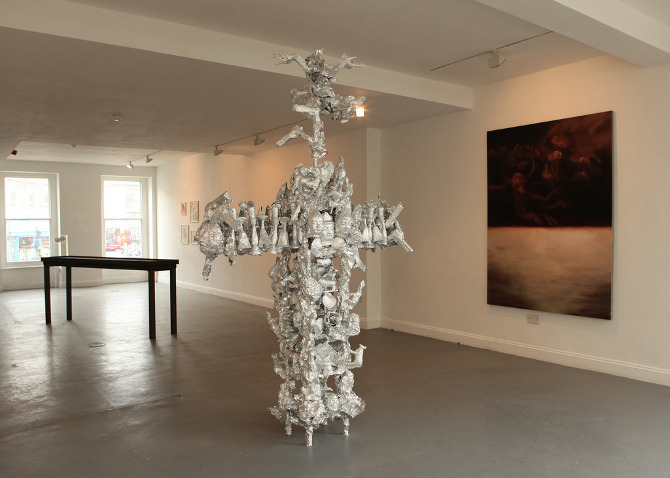 The third of three exhibitions curated by Lee Maelzer
15 April - 8 May 2011
“Traditionally, good comes from above, from heaven, while evil rises out of the earth. But with the first aerial bombardments, we learned that evil primarily inhabits the sky and rains down on the earth. And thus a certain ambiguity in relation to the heavens has developed. Not only at the level of the individual subjectivity of the artist, but in the consciousness of the masses as well.”
- Boris Groys
All Hail features five artists using a variety of media in an exhibition about the sky and its connotations, good or evil.
Some paint from an aerial viewpoint as though hovering at the rooftops or the horizon line. In other works there is an allusion to the sacred implications of stretching skyward. They explore electrical storms, atmospheric shifts and religious symbolism.
The magic and mystery of what is, or is imagined to be above us: clouds and the heavens, birds or bombs.
Iavor Lubomirov
Jonathan McLeod
Iain Nicholls
Douglas White
Laura White
The third of three exhibitions curated by Lee Maelzer
15 April - 8 May 2011
“Traditionally, good comes from above, from heaven, while evil rises out of the earth. But with the first aerial bombardments, we learned that evil primarily inhabits the sky and rains down on the earth. And thus a certain ambiguity in relation to the heavens has developed. Not only at the level of the individual subjectivity of the artist, but in the consciousness of the masses as well.”
- Boris Groys
All Hail features five artists using a variety of media in an exhibition about the sky and its connotations, good or evil.
Some paint from an aerial viewpoint as though hovering at the rooftops or the horizon line. In other works there is an allusion to the sacred implications of stretching skyward. They explore electrical storms, atmospheric shifts and religious symbolism.
The magic and mystery of what is, or is imagined to be above us: clouds and the heavens, birds or bombs.
Iavor Lubomirov
Jonathan McLeod
Iain Nicholls
Douglas White
Laura White

 Douglas White
Douglas White

 Iavor Lubomirov
Iavor Lubomirov





 Jonathan McLeod
Jonathan McLeod


 Laura White
Laura White


 Iain Nicholls
Iain Nicholls













 The second of three shows curated by Lee Maelzer.
18 March - 10 April 2011
City Hobgoblins, from the Fall song of the same name, features seven London artists whose work deals in some way with reality slippage.
Whilst being loosely figurative and working in a variety of media, the common thread is the sort of distortions that occur in dreams and nightmares, from drugs or religious visitations.
Anamorphic, inverted, truncated and shredded images that refer to the head and body. Human/animal hybrids appear in drawings and sculpture, relentless painted close-ups of wounds and photographic reflections, like double-takes, that make you question your peripheral vision.
This exhibition explores the angels and demons that can be released when you allow your senses enough freedom.
Darren Coffield
Oona Grimes
Tabitha Knight
Lisa Ivory
Paul Munn
Matthew Stradling
Julian Wakeling
The second of three shows curated by Lee Maelzer.
18 March - 10 April 2011
City Hobgoblins, from the Fall song of the same name, features seven London artists whose work deals in some way with reality slippage.
Whilst being loosely figurative and working in a variety of media, the common thread is the sort of distortions that occur in dreams and nightmares, from drugs or religious visitations.
Anamorphic, inverted, truncated and shredded images that refer to the head and body. Human/animal hybrids appear in drawings and sculpture, relentless painted close-ups of wounds and photographic reflections, like double-takes, that make you question your peripheral vision.
This exhibition explores the angels and demons that can be released when you allow your senses enough freedom.
Darren Coffield
Oona Grimes
Tabitha Knight
Lisa Ivory
Paul Munn
Matthew Stradling
Julian Wakeling













 The first of three shows curated by Lee Maelzer
19th February –13th March 2011
Painters’ Mate brings together seven disparate female painters in an investigation of the male in all his guises: partner, lover, husband, public figure, nemesis, sex object or combinations thereof. Awash with contradictions, jumbled images of past and present lovers mix with cool visions of distance and denial. Fantasies manifest with self-referential lusciousness or metaphorical detachment, while others are infused with humour and absurdity. Ultimately celebratory in tone, there are inescapable ambiguities explored in this exhibition. Sometimes explicit, sometimes spectacularly oblique, these artists express desire and tenderness, subjugation and fear.
Sophie Aston
Alyson Helyer
Lee Maelzer
Yuko Nasu
Miho Sato
Claude Vergez
Jo Wilmot
The first of three shows curated by Lee Maelzer
19th February –13th March 2011
Painters’ Mate brings together seven disparate female painters in an investigation of the male in all his guises: partner, lover, husband, public figure, nemesis, sex object or combinations thereof. Awash with contradictions, jumbled images of past and present lovers mix with cool visions of distance and denial. Fantasies manifest with self-referential lusciousness or metaphorical detachment, while others are infused with humour and absurdity. Ultimately celebratory in tone, there are inescapable ambiguities explored in this exhibition. Sometimes explicit, sometimes spectacularly oblique, these artists express desire and tenderness, subjugation and fear.
Sophie Aston
Alyson Helyer
Lee Maelzer
Yuko Nasu
Miho Sato
Claude Vergez
Jo Wilmot

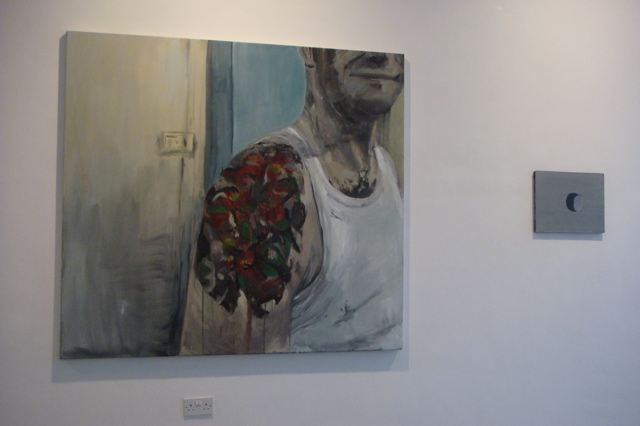
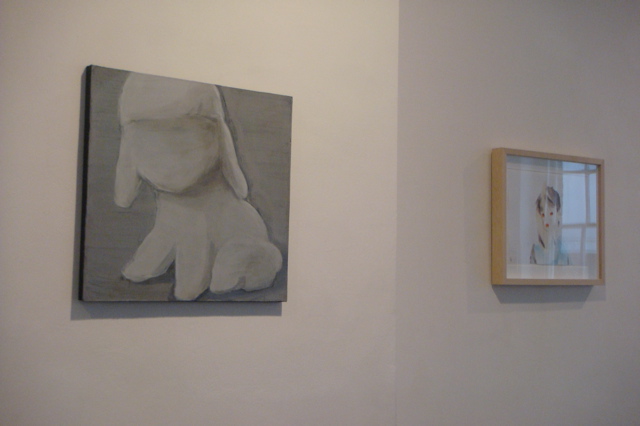
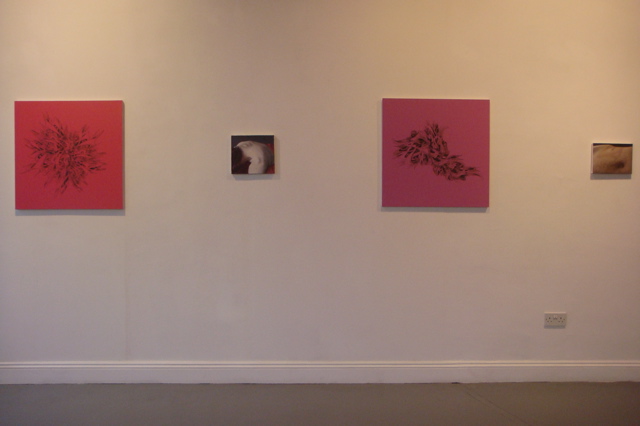

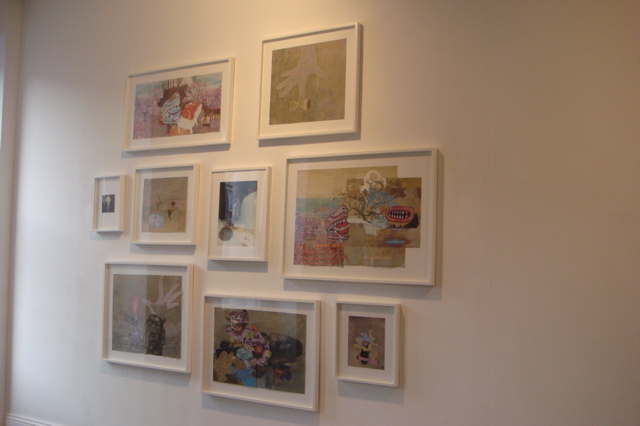
 ANGUS-HUGHES
presents
On Becoming a Gallery
An Exhibition in Three Parts: Curated by Fieldgate Gallery
Part Three: Jan 15th – Feb 6th
Aisling Hedgecock – Stewart Gough & Tom Ormond
Paul Eachus with videos by Nooshin Farhid
Private View: Friday, 14th January 2011, 6-9pm
Gallery open: Friday - Sunday, 12-6pm
Aisling Hedgecock
Part accelerated speleothem, part architectonic folly, 'The Ninth Stellation' is a large polychrome sculpture by Aisling Hedgecock made specifically for On Becoming A Gallery. Constructed from an apparently infinite number of polystyrene beads and found Spanish religious ephemera, cut and folded into stellated icosahedrons, Hedgecock employs both meticulous craft and process-led action to transform prosaic materials into pareidolic semblances of biogeological growth.
Stewart Gough & Tom Ormond
Stewart Gough and Tom Ormond continue their collaborative investigation into the sculptural and architectural space around and in between their individual practices. Their two previous collaborations are large scale sculptural works: DeBeauvoir Manor (2006); a Tudor cottage façade made from salvaged loading pallets and plasterboard, which through experience in the round breaks down into a formal abstraction of blue sail like structures. European Vacation (2006-9), is a manipulation beyond the readymade of a ‘Rapido’ folding caravan. Here the existing flat pack panels are re-cut, trimmed and fitted with further hinges, enabling the caravan’s unpacking to continue beyond its designed function, taking flight into abstraction. For ‘Becoming a Gallery’; Gough and Ormond respond to the curators request to provide a wall structure within the exhibition space. They use this opportunity to consider the operation and influence of a partition within the dynamics of an exhibition. Tom Ormond appears courtesy of Alison Jacques Gallery
Paul Eachus’s installations and photoworks are presented, perhaps even propositioned by a series of events, something has taken place, is about to take place or is in the process of taking place. Each event then is in process, not static but in a moment of becoming, it is in this sense transitory; it is unstable. It evokes Deleuze’s notion of ‘delire’, the ‘straight furrows’ fixed by society’s processes of categorisation and the channeling of things into their bracketed places are ruptured and the perverse and the irreconcilable are given the space to form new dialogues.
Nooshin Farhid produces video works whilst employing different subjects and scenarios that have a connecting thread, a commonality, namely there is a certain kind of agitation, a restlessness and a deliberate disjuncture that ruptures the familiar trajectory of the traditional narrative. This agitation, and an unwillingness to settle for what is ‘on offer’ (this is the way things are), reflects upon the current state of things socially, politically and ideologically.
On Becoming a Gallery
When a new gallery space opens does it become into the world in the way an artwork does? The Deleuzian notion of becoming is not linear, but a simultaneous realisation of the constituent parts in the becoming of its nature. It is a perception not a process: “We are not in the world; we become with the world; we become by contemplating it. Everything is vision, becoming”. With a gallery however, there is a process over time too. This happens on many levels: the introduction of artworks, the trace of its former usage, the accumulative history of exhibitions that the space establishes, the history that each participant and visitor brings. All of these elements then create a context in which the artworks and gallery are experienced and understood, and it is this dialogue that then becomes the gallery’s nature.
When Fieldgate Gallery was asked to curate the inaugural three-exhibition residency at the Angus-Hughes gallery it seemed an interesting prospect to approach it from these different notions of becoming. By definition there will be a linear narrative – all processes take place over time (in this case over the three exhibitions), but the analogy of becoming as a curatorial device remains intriguing. With that in mind the exhibition programme addresses these aspects of realising the gallery over its given chronological time-frame, from its state as an empty space. Through this, each of the exhibitions in different ways, reveal the gallery space as a site of expectations and meanings.
There is no theme, no critical context, no text. It is about filling a space full of stuff over a three-exhibition period and giving it significance. It is about decisions and percepts, it is about “…the organisation of perceptions, affections, and opinions…that take the place of language”, and when words fail, as they will, then all that is left is to do is as Laurence Sterne describes in ‘Life and Opinions of Tristram Shandy’: “When Corporal Trim flourishes his stick, we are given not the words but a twirling line on the page”.
Richard Ducker, 2010
Fieldgate Gallery
07957 228351 / fieldgategallery@gmail.com / www.fieldgategallery.com
ANGUS-HUGHES
presents
On Becoming a Gallery
An Exhibition in Three Parts: Curated by Fieldgate Gallery
Part Three: Jan 15th – Feb 6th
Aisling Hedgecock – Stewart Gough & Tom Ormond
Paul Eachus with videos by Nooshin Farhid
Private View: Friday, 14th January 2011, 6-9pm
Gallery open: Friday - Sunday, 12-6pm
Aisling Hedgecock
Part accelerated speleothem, part architectonic folly, 'The Ninth Stellation' is a large polychrome sculpture by Aisling Hedgecock made specifically for On Becoming A Gallery. Constructed from an apparently infinite number of polystyrene beads and found Spanish religious ephemera, cut and folded into stellated icosahedrons, Hedgecock employs both meticulous craft and process-led action to transform prosaic materials into pareidolic semblances of biogeological growth.
Stewart Gough & Tom Ormond
Stewart Gough and Tom Ormond continue their collaborative investigation into the sculptural and architectural space around and in between their individual practices. Their two previous collaborations are large scale sculptural works: DeBeauvoir Manor (2006); a Tudor cottage façade made from salvaged loading pallets and plasterboard, which through experience in the round breaks down into a formal abstraction of blue sail like structures. European Vacation (2006-9), is a manipulation beyond the readymade of a ‘Rapido’ folding caravan. Here the existing flat pack panels are re-cut, trimmed and fitted with further hinges, enabling the caravan’s unpacking to continue beyond its designed function, taking flight into abstraction. For ‘Becoming a Gallery’; Gough and Ormond respond to the curators request to provide a wall structure within the exhibition space. They use this opportunity to consider the operation and influence of a partition within the dynamics of an exhibition. Tom Ormond appears courtesy of Alison Jacques Gallery
Paul Eachus’s installations and photoworks are presented, perhaps even propositioned by a series of events, something has taken place, is about to take place or is in the process of taking place. Each event then is in process, not static but in a moment of becoming, it is in this sense transitory; it is unstable. It evokes Deleuze’s notion of ‘delire’, the ‘straight furrows’ fixed by society’s processes of categorisation and the channeling of things into their bracketed places are ruptured and the perverse and the irreconcilable are given the space to form new dialogues.
Nooshin Farhid produces video works whilst employing different subjects and scenarios that have a connecting thread, a commonality, namely there is a certain kind of agitation, a restlessness and a deliberate disjuncture that ruptures the familiar trajectory of the traditional narrative. This agitation, and an unwillingness to settle for what is ‘on offer’ (this is the way things are), reflects upon the current state of things socially, politically and ideologically.
On Becoming a Gallery
When a new gallery space opens does it become into the world in the way an artwork does? The Deleuzian notion of becoming is not linear, but a simultaneous realisation of the constituent parts in the becoming of its nature. It is a perception not a process: “We are not in the world; we become with the world; we become by contemplating it. Everything is vision, becoming”. With a gallery however, there is a process over time too. This happens on many levels: the introduction of artworks, the trace of its former usage, the accumulative history of exhibitions that the space establishes, the history that each participant and visitor brings. All of these elements then create a context in which the artworks and gallery are experienced and understood, and it is this dialogue that then becomes the gallery’s nature.
When Fieldgate Gallery was asked to curate the inaugural three-exhibition residency at the Angus-Hughes gallery it seemed an interesting prospect to approach it from these different notions of becoming. By definition there will be a linear narrative – all processes take place over time (in this case over the three exhibitions), but the analogy of becoming as a curatorial device remains intriguing. With that in mind the exhibition programme addresses these aspects of realising the gallery over its given chronological time-frame, from its state as an empty space. Through this, each of the exhibitions in different ways, reveal the gallery space as a site of expectations and meanings.
There is no theme, no critical context, no text. It is about filling a space full of stuff over a three-exhibition period and giving it significance. It is about decisions and percepts, it is about “…the organisation of perceptions, affections, and opinions…that take the place of language”, and when words fail, as they will, then all that is left is to do is as Laurence Sterne describes in ‘Life and Opinions of Tristram Shandy’: “When Corporal Trim flourishes his stick, we are given not the words but a twirling line on the page”.
Richard Ducker, 2010
Fieldgate Gallery
07957 228351 / fieldgategallery@gmail.com / www.fieldgategallery.com
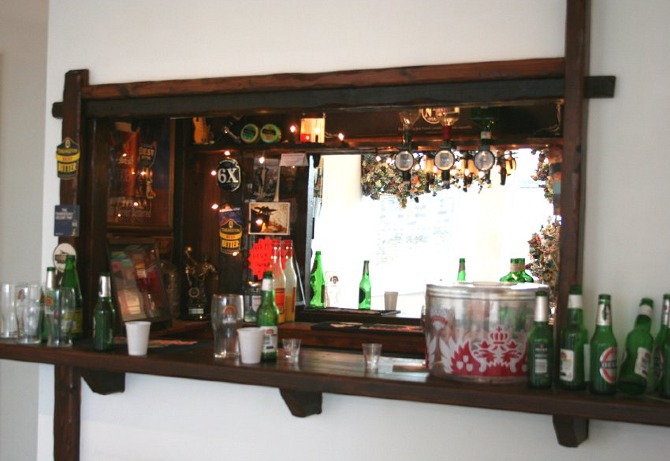

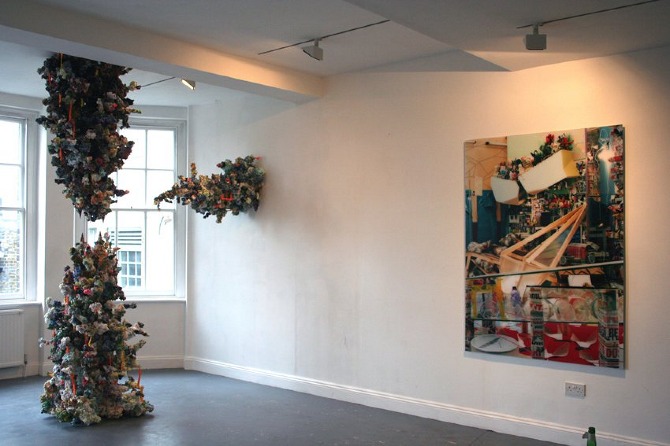

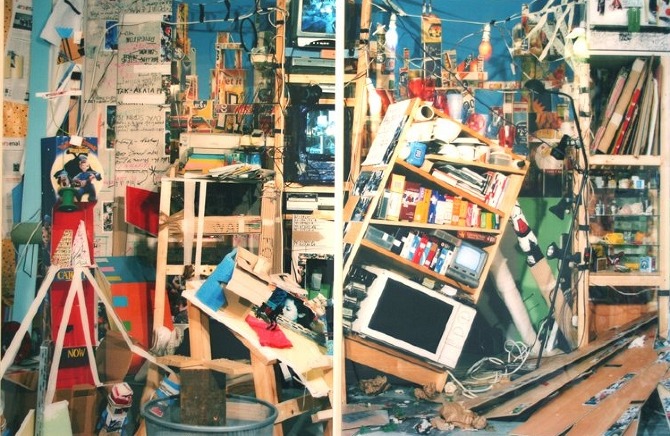
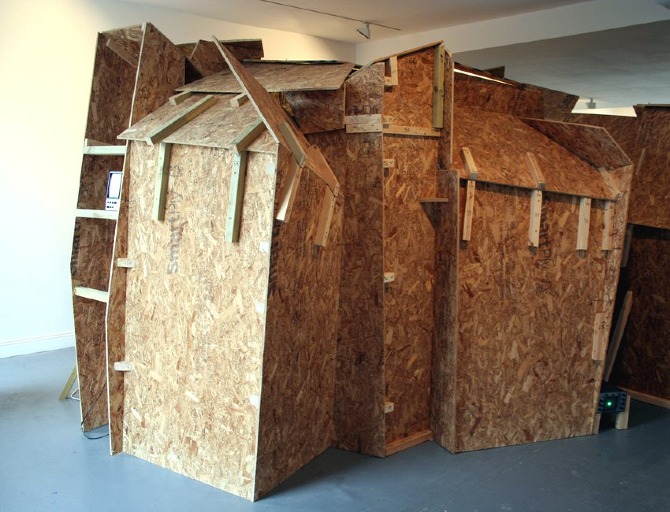
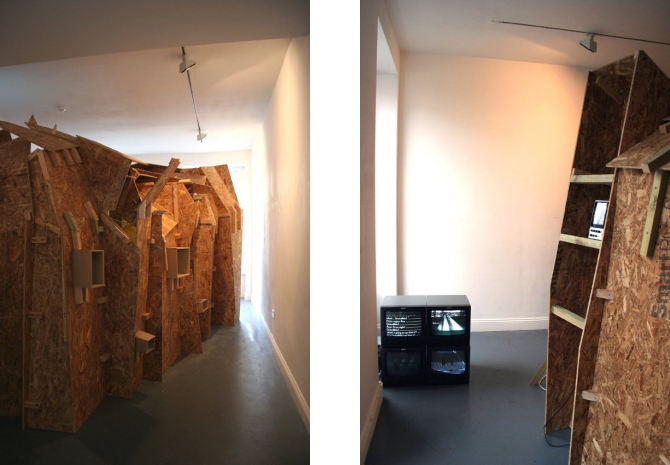
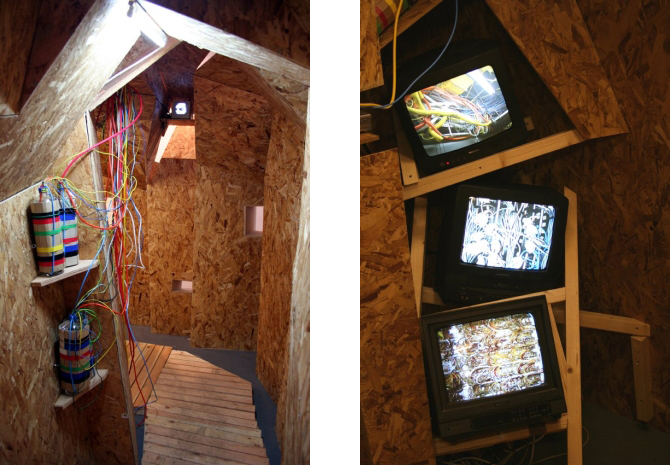

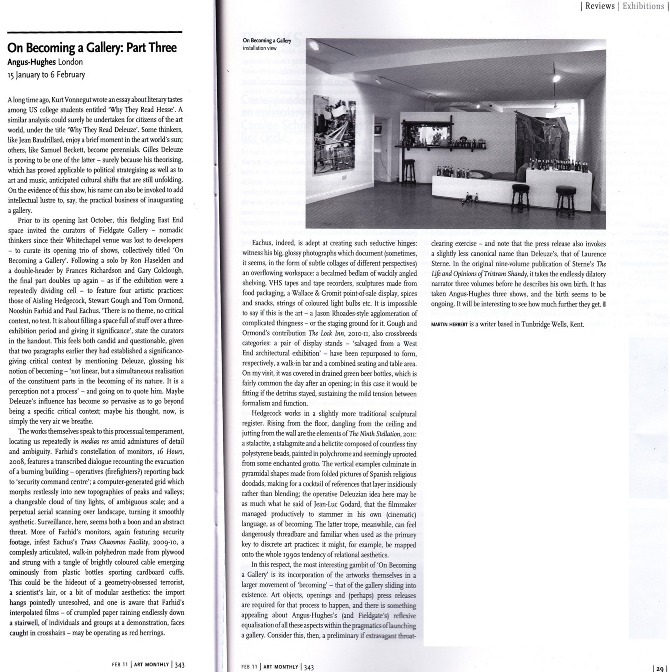

 ANGUS-HUGHES
presents
On Becoming a Gallery
An Exhibition in Three Parts: Curated by Fieldgate Gallery
Part Two: Nov 27th – Dec 19th
Frances Richardson - Gary Colclough
Private View: Friday November 26th, 6-9pm
Gallery open: Friday - Sunday, 12-6pm
Frances Richardson describes her sculptural works as “walk-in drawings”. The intent is that the viewer becomes part of an imaginary field within actual space. In this field tables, chairs, I-beams, floorboards, carpets, beds etc. are “drawn” using MDF/plywood in 3 dimensions. Paired down to structural forms they effect through their physical presence, denying the seduction of surface histories.
Gary Colclough’s practice encompasses drawing, sculpture and projections. Central to his work is the presentation of hand-drawn images combined with diagrammatic wooden structures. Through various formal combinations of these elements he explores how the image functions as an element within spatial and temporal arrangements.
On Becoming a Gallery
When a new gallery space opens does it become into the world in the way an artwork does? The Deleuzian notion of becoming is not linear, but a simultaneous realisation of the constituent parts in the becoming of its nature. It is a perception not a process: “We are not in the world; we become with the world; we become by contemplating it. Everything is vision, becoming”. With a gallery however, there is a process over time too. This happens on many levels: the introduction of artworks, the trace of its former usage, the accumulative history of exhibitions that the space establishes, the history that each participant and visitor brings. All of these elements then create a context in which the artworks and gallery are experienced and understood, and it is this dialogue that then becomes the gallery’s nature.
When Fieldgate Gallery was asked to curate the inaugural three-exhibition residency at the Angus-Hughes gallery it seemed an interesting prospect to approach it from these different notions of becoming. By definition there will be a linear narrative – all processes take place over time (in this case over the three exhibitions), but the analogy of becoming as a curatorial device remains intriguing. With that in mind the exhibition programme addresses these aspects of realising the gallery over its given chronological time-frame, from its state as an empty space. Through this, each of the exhibitions in different ways, reveal the gallery space as a site of expectations and meanings.
There is no theme, no critical context, no text. It is about filling a space full of stuff over a three-exhibition period and giving it significance. It is about decisions and percepts, it is about “…the organisation of perceptions, affections, and opinions…that take the place of language”, and when words fail, as they will, then all that is left is to do is as Laurence Sterne describes in ‘Life and Opinions of Tristram Shandy’: “When Corporal Trim flourishes his stick, we are given not the words but a twirling line on the page”.
Richard Ducker, 2010
Part Three: Jan 15th – Feb 6th
Aisling Hedgecock – Stewart Gough & Tom Ormond
Paul Eachus with videos by Nooshin Farhid
Fieldgate Gallery
07957 228351 / fieldgategallery@gmail.com / www.fieldgategallery.com
Frances Richardson
ANGUS-HUGHES
presents
On Becoming a Gallery
An Exhibition in Three Parts: Curated by Fieldgate Gallery
Part Two: Nov 27th – Dec 19th
Frances Richardson - Gary Colclough
Private View: Friday November 26th, 6-9pm
Gallery open: Friday - Sunday, 12-6pm
Frances Richardson describes her sculptural works as “walk-in drawings”. The intent is that the viewer becomes part of an imaginary field within actual space. In this field tables, chairs, I-beams, floorboards, carpets, beds etc. are “drawn” using MDF/plywood in 3 dimensions. Paired down to structural forms they effect through their physical presence, denying the seduction of surface histories.
Gary Colclough’s practice encompasses drawing, sculpture and projections. Central to his work is the presentation of hand-drawn images combined with diagrammatic wooden structures. Through various formal combinations of these elements he explores how the image functions as an element within spatial and temporal arrangements.
On Becoming a Gallery
When a new gallery space opens does it become into the world in the way an artwork does? The Deleuzian notion of becoming is not linear, but a simultaneous realisation of the constituent parts in the becoming of its nature. It is a perception not a process: “We are not in the world; we become with the world; we become by contemplating it. Everything is vision, becoming”. With a gallery however, there is a process over time too. This happens on many levels: the introduction of artworks, the trace of its former usage, the accumulative history of exhibitions that the space establishes, the history that each participant and visitor brings. All of these elements then create a context in which the artworks and gallery are experienced and understood, and it is this dialogue that then becomes the gallery’s nature.
When Fieldgate Gallery was asked to curate the inaugural three-exhibition residency at the Angus-Hughes gallery it seemed an interesting prospect to approach it from these different notions of becoming. By definition there will be a linear narrative – all processes take place over time (in this case over the three exhibitions), but the analogy of becoming as a curatorial device remains intriguing. With that in mind the exhibition programme addresses these aspects of realising the gallery over its given chronological time-frame, from its state as an empty space. Through this, each of the exhibitions in different ways, reveal the gallery space as a site of expectations and meanings.
There is no theme, no critical context, no text. It is about filling a space full of stuff over a three-exhibition period and giving it significance. It is about decisions and percepts, it is about “…the organisation of perceptions, affections, and opinions…that take the place of language”, and when words fail, as they will, then all that is left is to do is as Laurence Sterne describes in ‘Life and Opinions of Tristram Shandy’: “When Corporal Trim flourishes his stick, we are given not the words but a twirling line on the page”.
Richard Ducker, 2010
Part Three: Jan 15th – Feb 6th
Aisling Hedgecock – Stewart Gough & Tom Ormond
Paul Eachus with videos by Nooshin Farhid
Fieldgate Gallery
07957 228351 / fieldgategallery@gmail.com / www.fieldgategallery.com
Frances Richardson

 Gary Colclough
Gary Colclough
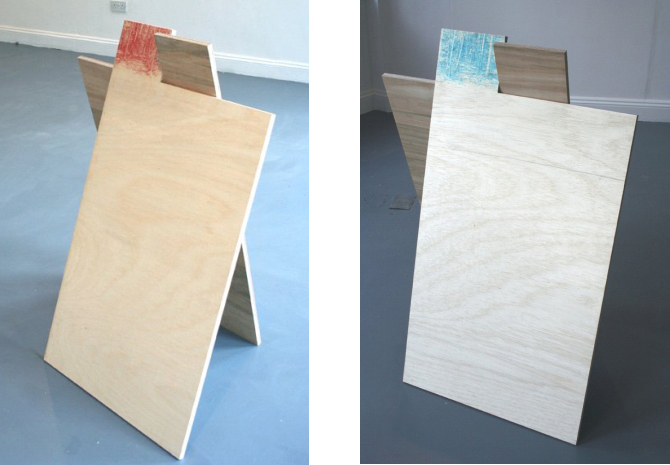




 Fieldgate Gallery is very happy to present a site-specific installation by Ron Haselden. This will be the inaugural exhibition at the Angus-Hughes Gallery as part of a series of three exhibitions curated by Fieldgate:
ANGUS-HUGHES
Presents
On Becoming a Gallery
An Exhibition in Three Parts: Curated by Fieldgate Gallery
Part One: Oct 21st – Nov 14th
Ron Haselden ‘October’
Private View: Wednesday 20th October, 6-9pm
What Ron Haselden has made is a contingent way of knowing as an object, but what it conjures is the subject who asks in the first place. It’s this subject that fills the room, locates itself in space, rises and drops. It is a happy coming together of a way of asking and a way of knowing, and the sustained suspension of the consistency of the self that this requires. Haselden’s work quietly and persistently transforms the facts of the world and the facts of the strings of thought into a monument to the bodily subject who asks.
Tim Martin, London, September 2008
Ron Haselden appears courtesy of Domo Baal Gallery
On Becoming a Gallery
When a new gallery space opens does it become into the world in the way an artwork does? The Deleuzian notion of becoming is not linear, but a simultaneous realisation of the constituent parts in the becoming of its nature. It is a perception not a process: “We are not in the world; we become with the world; we become by contemplating it. Everything is vision, becoming”. With a gallery however, there is a process over time too. This happens on many levels: the introduction of artworks, the trace of its former usage, the accumulative history of exhibitions that the space establishes, the history that each participant and visitor brings. All of these elements then create a context in which the artworks and gallery are experienced and understood, and it is this dialogue that then becomes the gallery’s nature.
When Fieldgate Gallery was asked to curate the inaugural three-exhibition residency at the Angus Hughes gallery it seemed an interesting prospect to approach it from these different notions of becoming. By definition there will be a linear narrative – all processes take place over time (in this case over the three exhibitions), but the analogy of becoming as a curatorial device remains intriguing. With that in mind the exhibition programme addresses these aspects of realising the gallery over its given chronological time-frame, from its state as an empty space. Through this, each of the exhibitions, in different ways, reveals the gallery space as a site of expectations and meanings.
There is no theme, no critical context, no text. It is about filling a space full of stuff over a three-exhibition period and giving it significance. It is about decisions and percepts, it is about “…the organisation of perceptions, affections, and opinions…that take the place of language”, and when words fail, as they will, then all that is left is to do is as Laurence Sterne describes in ‘Life and Opinions of Tristram Shandy’: “When Corporal Trim flourishes his stick, we are given not the words but a twirling line on the page”.
Richard Ducker, 2010
Part Two: Nov 27th – Dec 19th
Frances Richardson - Gary Colclough
Part Three: Jan 15th – Feb 6th
Aisling Hedgecock – Stewart Gough & Tom Ormond
Paul Eachus with videos by Nooshin Farhid
Fieldgate Gallery
07957 228351 / fieldgategallery@gmail.com / www.fieldgategallery.com
Fieldgate Gallery is very happy to present a site-specific installation by Ron Haselden. This will be the inaugural exhibition at the Angus-Hughes Gallery as part of a series of three exhibitions curated by Fieldgate:
ANGUS-HUGHES
Presents
On Becoming a Gallery
An Exhibition in Three Parts: Curated by Fieldgate Gallery
Part One: Oct 21st – Nov 14th
Ron Haselden ‘October’
Private View: Wednesday 20th October, 6-9pm
What Ron Haselden has made is a contingent way of knowing as an object, but what it conjures is the subject who asks in the first place. It’s this subject that fills the room, locates itself in space, rises and drops. It is a happy coming together of a way of asking and a way of knowing, and the sustained suspension of the consistency of the self that this requires. Haselden’s work quietly and persistently transforms the facts of the world and the facts of the strings of thought into a monument to the bodily subject who asks.
Tim Martin, London, September 2008
Ron Haselden appears courtesy of Domo Baal Gallery
On Becoming a Gallery
When a new gallery space opens does it become into the world in the way an artwork does? The Deleuzian notion of becoming is not linear, but a simultaneous realisation of the constituent parts in the becoming of its nature. It is a perception not a process: “We are not in the world; we become with the world; we become by contemplating it. Everything is vision, becoming”. With a gallery however, there is a process over time too. This happens on many levels: the introduction of artworks, the trace of its former usage, the accumulative history of exhibitions that the space establishes, the history that each participant and visitor brings. All of these elements then create a context in which the artworks and gallery are experienced and understood, and it is this dialogue that then becomes the gallery’s nature.
When Fieldgate Gallery was asked to curate the inaugural three-exhibition residency at the Angus Hughes gallery it seemed an interesting prospect to approach it from these different notions of becoming. By definition there will be a linear narrative – all processes take place over time (in this case over the three exhibitions), but the analogy of becoming as a curatorial device remains intriguing. With that in mind the exhibition programme addresses these aspects of realising the gallery over its given chronological time-frame, from its state as an empty space. Through this, each of the exhibitions, in different ways, reveals the gallery space as a site of expectations and meanings.
There is no theme, no critical context, no text. It is about filling a space full of stuff over a three-exhibition period and giving it significance. It is about decisions and percepts, it is about “…the organisation of perceptions, affections, and opinions…that take the place of language”, and when words fail, as they will, then all that is left is to do is as Laurence Sterne describes in ‘Life and Opinions of Tristram Shandy’: “When Corporal Trim flourishes his stick, we are given not the words but a twirling line on the page”.
Richard Ducker, 2010
Part Two: Nov 27th – Dec 19th
Frances Richardson - Gary Colclough
Part Three: Jan 15th – Feb 6th
Aisling Hedgecock – Stewart Gough & Tom Ormond
Paul Eachus with videos by Nooshin Farhid
Fieldgate Gallery
07957 228351 / fieldgategallery@gmail.com / www.fieldgategallery.com
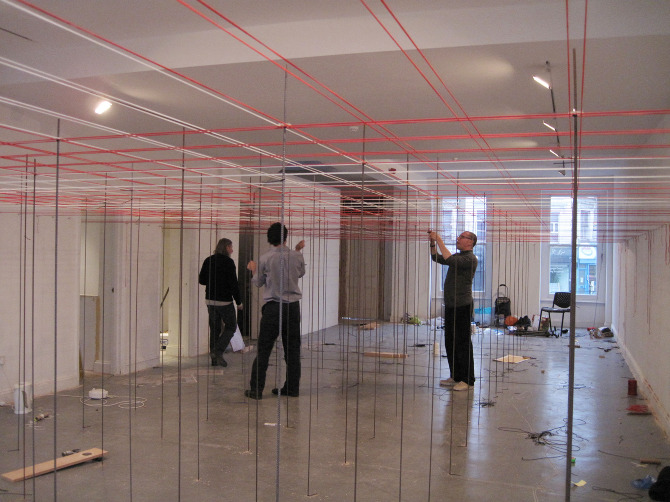
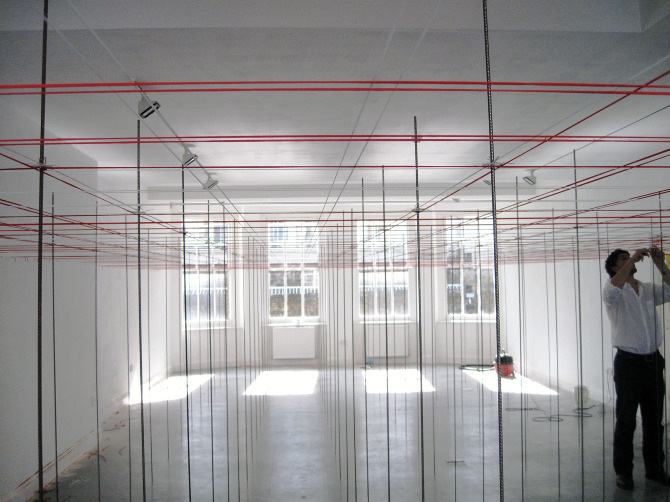
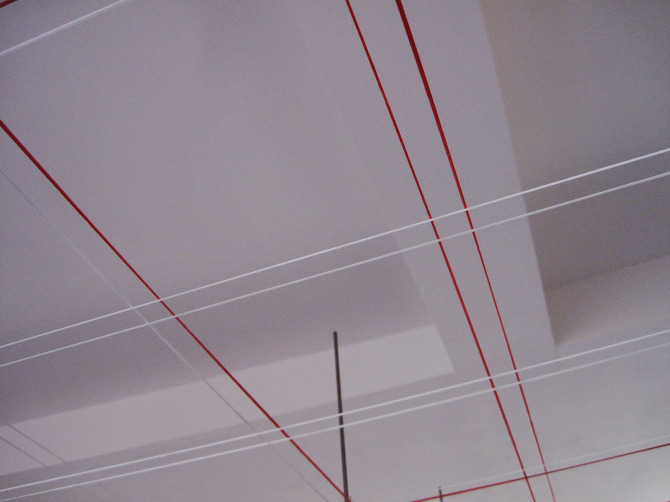


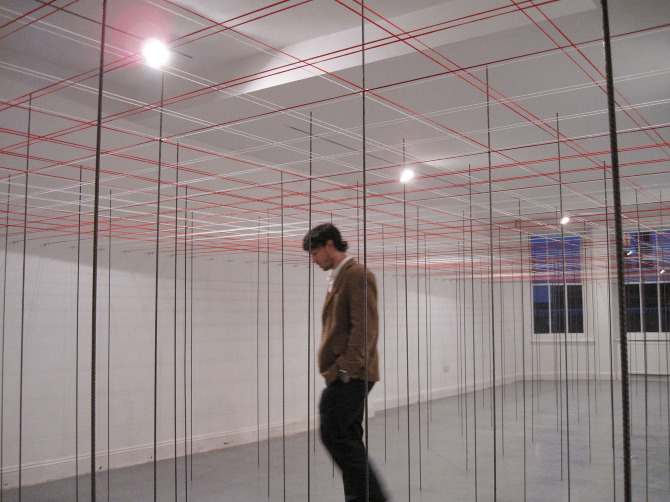

 In this solo exhibition at Angus-Hughes Gallery, Lee Maelzer presents a series of new paintings of dilapidated interiors.
Formerly inhabited urban spaces with only vestiges of their previous incarnations… graffiti, misplaced furniture, peeling paint and scattered debris.
They hint both at neglect and tense anticipation, in spite of the lack of a visible human presence.
Initially dark in palette, colours gradually reveal themselves, slowly emerging from the gloom.
In this solo exhibition at Angus-Hughes Gallery, Lee Maelzer presents a series of new paintings of dilapidated interiors.
Formerly inhabited urban spaces with only vestiges of their previous incarnations… graffiti, misplaced furniture, peeling paint and scattered debris.
They hint both at neglect and tense anticipation, in spite of the lack of a visible human presence.
Initially dark in palette, colours gradually reveal themselves, slowly emerging from the gloom.